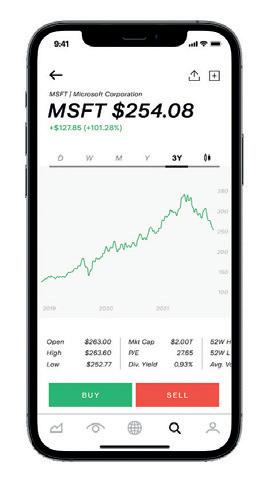

INFRASTRUCTURE A tale of two banks
The high street giant and the speedboat – how Cloud journeys compare
CRYPTO
The cr ypto wild child has grown up: but can it behave?



INFRASTRUCTURE A tale of two banks
The high street giant and the speedboat – how Cloud journeys compare
CRYPTO
The cr ypto wild child has grown up: but can it behave?
Jethro MacDonald explains how SmartStream has come up with a tool the investment industry might find hard to put down























18 Daring to dream
A new breed of fintech is transforming lives in India by turning the traditional education lending market on its head and releasing millions of dollars to students who’d never otherwise have been able to study. Swati Sanyal Tarafdar talks to the entrepreneurs driving change – and one of the students to benefit from it
35 Riding the IPO rollercoaster
Going for growth? Then make sure the figures stack up, says Mark Aubin, Senior VP of Solutions Consulting at Aptitude Software, which is helping CFOs to meet the revenue management challenge
48 Time to share?
ATM pooling is taking off in many markets, both cashless and cash-heavy, says Karolina Rachwol at RBR REPORTING & REGTECH
6 Rules of conduct
SmartStream has combined its deep knowledge of regulatory reference data and super-fast, Cloud-based, AI-driven reconciliation to solve the investment industry’s reporting challenges. And – perhaps surprisingly – digital assets traders are clamouring for it, too, says Jethro MacDonald
11 Risk and reward
In an increasingly unpredictable compliance environment, Trulioo is giving companies confidence and control around their IDV. It’s creating new business opportunities in an uncertain world, says Hal Lonas
15 Cracking the KYC nut
Does a big bank like NatWest have lessons for challengers when it comes to regulatory oversight? We asked its Head of Digital Jonathan Hall CLOUD
24 Journeys through the Clouds UK banks of all shapes and sizes are turning to Cloud environments as they search for scalability, operational efficiency and resilience. We asked Gary Delooze, CIO at high street building society Nationwide, and Wayne Freeman, CTO of NatWest’s neobank for SMEs, Mettle, to tell us more about their organisations’ experiences
29 Sweet harmony
TSB’s Kavin Mistry on keeping customers happy in a complex multi-Cloud, physical and digital environment
38 When the ‘enfant terrible’ of finance becomes the adult in the room
The wild child of finance is finally being taken seriously by the adults... the institutions and regulators which dismissed and ignored it, have come to realise that crypto was a prodigy they mis-took for a delinquent. Three leading members of the altfi economy came together recently to discuss what maturity looks like
42 The CBDC conundrum
Are central bank digital currencies a solution in search of a problem, or a race to the future of money?
ProgressSoft’s Hussein Jundi and payment consultant Jeff Stewart explore the pros and cons
45 Grabbing Wall Street by the horns
Aussie trading app Stake set out to liberate retail investors by giving them direct access to the biggest stock market in the world. Crypto asset trading represents the next financial reedom, says its CEO BANKING-AS-A-SERVICE
51 Service with a smile
Tom Bentley from platform player Vodeno and Martin Häring of banking technology provider
Temenos on how the next megatrend in banking is likely to shape up
54 Gold BaaS
During the first wave of fintech disruption, banks feared they would be condemned to irrelevance. Now, that’s very far from the case, says Finastra’s Angus Ross LENDING
58 Moving on… and up
With rampant property price inflation, many first-time buyers in the UK despair of ever owning a home of their own. Startup Keyzy believes it’s found a solution
61 Chain reaction
Lack of trade finance for SMEs threatened to bring supply chains to a halt in 2020. Martin McCann from Trade Ledger and Barclays Bank’s James Binns consider how a more collaborative approach could keep them moving in future
65 Take your partner
The first BaaS Market Maturity Index from Finastra has identified a wide open goal to improve lending and other services to SMEs. Dee Burke and Josh Cogan walk us through the results







So, banking-as-a-service is emerging as a strong theme in this issue – not by design.
But I guess that’s just evidence that what it represents – the maturing and mass adoption of technologies including Cloud, AI and APIs, combined with a new perspective on the role of finance, and who orchestrates it (i.e. it’s no longer the exclusive territory of old-world institutions) – has moved from an aspiration to reality.

Now, we’re not talking about what it might do, but if there’s anything it can’t. It’s now beginning to impact every aspect our lives – and not just in purely monetary terms, but in addressing real-world issues and real people’s problems that couldn’t be adequately solved under the old, top-down, hierarchical financial system.
Will we be saying the same thing about crypto in 10 years’ time? Notwithstanding Bitcoin’s latest cyclical correction and the Terra ecosystem’s collapse, driven by some bizarre strategic decisions, mainstream investors, corporates and

banks are now finding jobs for crypto to do. There is still a lot of nervousness – among regulators who still don’t have a firm grasp of this new phenomenon, just as much as mainstream institutions concerned that they might miss the boat. But one thing is for certain: crypto is a pebble in the financial system’s shoe that it won’t now shift. And if it makes it walk in a slightly different way, maybe that’s no bad thing.
Sue Scott, EditorDid you recognise Issue 23’s spine tingler? “Always give 100 per cent. Unless you are giving blood” – American actor and comedian

SALES TEAM
Tom Dickinson
Shaun Routledge
Nicole Efthymiou
VIDEO TEAM
IMAGES BY www.istock.com
PRINTED
"PROUDLY NOT

Lewis Averillo-Singh
Lea Jakobiak Oliver Chapman

ABC AUDITED"


SmartStream has combined its deep knowledge of regulatory reference data and super-fast, Cloud-based, AI-driven reconciliation, to solve the investment industry’s reporting challenges. And – perhaps surprisingly –digital assets traders are clamouring for it, too, says
The second Markets in Financial Instruments Directive (MiFID II) isn’t something you want to bring up in a dinner party conversation with investment managers. Why spoil a perfectly good evening? It’s likely to have them reaching for the Hors d’Age brandy and dabbing beads of sweat from their brows.
Four years ago, they might have been more sanguine, bullish even, about the impact of what was seen as one of the most important regulatory initiatives of the EU since the global financial crisis.
But then came two years of getting compliance systems, which were largely manually based, up to speed as the subsequent Markets in Financial Instruments Regulation (MiFIR) was embedded into European member states’ legislation.
In 2021, the first report from the European Securities and Markets Authority (ESMA) revealed how the industry was doing: badly. Figures showed that the number of penalties imposed across Europe for breaching the rules had quadrupled from €1.8million in 2019 to €8.4million in 2020.
And these transgressions weren’t committed by small family offices, but large organisations, with teams dedicated to compliance, handling thousands of transactions. Big trading venues were falling foul of the rules, too.
While the huge increase in regulatory action could perhaps be partly explained by the way national authorities identified and reported breaches to ESMA during that difficult honeymoon period, research the same summer from financial services advisory firm ACA Group found that almost all firms it surveyed were still incorrectly reporting transactions. And the majority didn’t even know it.
Complying with the demands of MiFID II transaction reporting is undeniably complex; and proving the integrity of that data to regulators can place a real strain on organisations, according to transaction lifecycle management (TLM) solutions provider SmartStream. It was only too well aware of the immense pressure the directive was likely to put on firms
Jethro MacDonaldmanually bringing together data, as most were, from multiple data sources in non-aligned formats, at immense scale.
It had been operating in the field for years, developing sophisticated, automated reconciliation software to give businesses better insight into their data and improve accuracy and processing speeds. But its decision to move its services to the Cloud, where it could infinitely scale resources and to make research and development of artificial intelligence (AI) and machine learning (ML) a strategic priority, put it on the front foot when the reality of MiFID II began to sink in.
SmartStream’s AI-driven, Cloud-native solution, AIR (Artificial Intelligence Reconciliations), is capable of reconciling ‘volumes of data that are unheard of in our industry; not just millions of rows, but billions of rows’, says Jethro MacDonald, product manager of AI and machine learning at the SmartStream Innovation Lab.
“SmartStream AIR is a solution to the painful manual onboarding process of building new reconciliations. We speed up the whole process,” he continues. “Throw AIR two files and it will tell you how they come together – in seconds. Then you can make informed decisions as to whether you want to change those match rules or not.
“On top of that, we use ML: if a user is manually matching data, we learn from their behaviour, then propose matches to that client based on what the ML has observed. That means it’s not just helping with onboarding, but with day-to-day tasks, too.”
For many, meeting MiFID II compliance requirements is onerous. “Under RTS 22, Article 15 of MiFID II, firms have to reconcile from their front-office systems to the regulator, ensuring there are no gaps or reporting errors,” says MacDonald.

That can involve up to 65 fields of information which must be completed as part of daily trading activity – information that will be used by regulators to monitor, for example, who is involved in a trade, and, in combination with other reports, perhaps flag market abuse. Too little or missed information risks censure; but neither do firms want to spend time on going to unnecessary effort.
“We not only give clients the means to reconcile the data and demonstrate the accuracy of their transaction reporting processes to the regulator, but we can also tell them whether their reporting decision is correct,” explains MacDonald. And that’s the game changer.
SmartStream achieves it by using an API to link two of its existing solutions: near-real-time reconciliations provided by AIR; and SmartStream Reference Data Utility (RDU), which tracks data from regulatory and industry bodies. It sensechecks what data the regulator actually requires, including validating whether a financial instrument is traded via a trading venue and is therefore reportable – or not.
SmartStream claims the resulting tool – Transaction Reporting Reconciliation and Reporting Decision Control – is an industry first. “It’s certainly a really exciting use of the technology,” says MacDonald.
So, that’s the firms, but what about the trading venues? They have to meet an even higher bar.
We not only give clients the means to reconcile the data and demonstrate the accuracy of their transaction reporting processes to the regulator, we can also tell them whether their reporting decision was correct or not

Post-Brexit, ESMA increased the data continuity checks that trading venues must perform when reporting instrument reference and quantitative data. Any irregularities must be accounted for and mistakes re-reported, so that ESMA can meet its publishing timelines. That includes for instrument liquidity, size-specific-to-instrument and large-in-scale calculations.
At present, trading venues typically check their records retrospectively, on a three-month basis, against massive ESMA data files. This highly complex exercise is costly and accompanied with a huge operational burden.
“The obligation on trading venues, from a MiFID perspective, is so much more than for any other firm,” says MacDonald. “Importantly, the regulator reconciles their reference data and the quantitative data. The problem here is that there are nuances between these two reports, which means some instruments are reportable on one, and not on the other. You need really specialist reference data to help you with that.
“So, again, we’ve combined internally with the RDU, to feed in the reference data needed to make really important decisions, and, instead of asking the client for their reference data report, we’re taking that directly from ESMA, because it’s publicly available information. All the trading venue has to do, then, is submit their quantitative report to us, and we’ll tell them whether they have an issue or not. And that’s carried out proactively, daily.”
The new regulatory solution, Trading Venue Quantitative Reporting Outlier Reconciliation, was launched in March of this year.
By virtue of the fact that SmartStream works with 70 of the world’s top 100 banks, capital markets, buy-side firms and corporations, it has eyes across the industry and that gives its clients another major advantage when it comes to whether they are on the right side of regulations that are often hard to accurately interpret, andin a state of constant flux.
“The more data you have, the more


powerful the AI,” says MacDonald. “So, we’re looking at how we can use AI to tell us how the data comes together across multiple entities, to see if there are any reporting differences between a firm and its peers. That’s huge for them because, while there are validation rules in place, at the moment, in regulation, that doesn’t tell you if what you’re reporting is in line with that of the rest of the market.”
It could give an early signal of whether a firm is over or under-reporting, both of which it’s wise to avoid. “In fact, recent fines have all been around over-reporting,” says MacDonald. “And some of these issues may not be flagged to users until weeks, months, even years later.”
Waiting, oblivious of some indiscretion, until a surprise knock on the door from prosecutors, isn’t good for business, and neither is the lack of contemporaneous reporting and monitoring for policing the world’s financial markets.
Like the weather, those markets are constantly changing. ESMA has already proposed amendments to MiFIR transactions and reference data reporting regimes, and, since the UK has taken a different regulatory path, following Brexit, they may well not align in future. But there are other winds blowing.
“Right now, digital assets aren’t regulated, but, at some point, ESMA will review them. We saw that between MiFID I and MiFID II; we started reporting a lot more derivatives under MiFID II,” says MacDonald. “From a foreign exchange (FX) perspective, I wonder
The obligation on trading venues, from a MiFID perspective, is so much more than for any other firm
if cryptocurrencies will be regulated, because FX isn’t directly; however, I imagine cryptocurrency derivatives will be, in the next couple of years. We’ll certainly adapt our systems to meet those regulations.”
Perhaps encouragingly for SmartStream, given the potential disruption that decentralised finance could cause incumbents, digital asset companies have been seeking it out, reveals MacDonald.
“One of the things we’d hear people say is ‘what’s the use of reconciliation tools anymore? They’re not going to be needed?’. But, actually, we’ve found the opposite. These firms themselves have a number of controls they need to meet.
“Trading venues, crypto firms, these companies are using the latest technology, too. So it’s not hard trying to sell AIR to them! They understand the technology, they know the power of it, so we work quite well together in delivering a combined control framework.
“We’re more than willing to help them with any reconciliation needs they have. We’re always looking at how we can improve our tools and create new products that will help the industry.”


























Banking Circle’s proprietary technology enables Payments businesses and Banks of any scale to seize opportunities, compete and grow.
From multi-currency accounts to real-time FX, international payments to local clearing, we’re quick, low-cost, and secure.
Bypass old, bureaucratic and expensive systems and enable global banking services for your clients.
bankingcircle.com



In an increasing unpredictable compliance environment, Trulioo is giving companies confidence and control of their IDV. It’s creating new business opportunities in an uncertain world, says Hal Lonas

Whether you’re a financial institution, big corporate or SME, staying on the right side of compliance when it comes to screening new and existing clients and suppliers is becoming increasingly hazardous, especially if you operate in multiple jurisdictions.
It’s not helped that since the sanctions curtain came down on Russia, governments opposed to its invasion of Ukraine have been moving the regulatory pieces at different speeds across the geopolitical board. What looks like a legitimate business relationship one minute could prove a toxic mistake the next.
At last count (May), there were, for instance, 148 Russian-linked entities and 1,255 individuals whom the UK government alone had made subject of asset freezes. That included manufacturing companies, research institutes, banks and insurers, among others.
Breaching financial sanctions in relation to any one of those carries a maximum prison sentence of seven years or a fine (or both) – not to mention the reputational damage of being publicly excoriated for indirectly supporting ‘Putin’s war’. With the economic thumbscrews
being applied to major international companies and smaller entities alike, banks could perhaps be forgiven for taking a low/no-risk approach to onboarding SMEs, especially as they have historically been more expensive to service, anyway.
Hal Lonas, chief technology officer for global identity verification (IDV) platform Trulioo says that needn’t be the case if they let a third-party specialist pipe in the technology that ensures real-time and comprehensive know your customer and know your business verification – in its case, drawing from both structured and unstructured data way beyond the reach of most internal compliance teams.
Trulioo’s data comes from 450-plus data sources in around 195 countries, and, thanks to the company’s recent acquisition of HelloFlow, it can now be offered to customers with a no-code tool so they can bespoke how that information is used in-house, further reducing the cost of customer acquisition.
HelloFlow’s no-code, drag-and-drop solution for customer onboarding, will dovetail with Trulioo’s existing proprietary tools – GlobalGateway, eIDV, KYB and DocV – to assist in both individual and business ID verification to provide a single, holistic IDV platform aimed at saving financial institutions time, money and, potentially, penalties. So, far from retreating from sections of the business community that might have been seen as too difficult to serve because of KYB limitations, the technology can unlock opportunities, says Lonas.
“More and more, the smallest company looks the same as the biggest company; you need to know where they’re doing business, the problems that they’re solving,” he says.
If financial institutions can overcome the onboarding hurdle, then digital enablement will drive the conversion of that business to them.
“A lot of financial institutions looked at SMEs before and said ‘do I want to do business with a smaller company? Is it worth the investment to get them on board?’,” says Lonas.
“Now, with that particular friction point going away, they can look at SMEs as the new greenspace opportunity. With onboarding costs lower, they can afford to really serve SMEs with a much wider range of solutions.”

A tricky balance: If they can reduce the cost of compliance, banks might look more favourably on SMEs
The Russia-Ukraine conflict has added to the pressure that Trulioo had already seen building on banks following revelations contained in the Panama Papers and, later, the Pandora Papers, which exposed the criminal and tax-evading practices of some of the world’s richest, most famous and powerful individuals.
Originally released in 2021, further investigation of the Pandora Papers by the International Consortium of Investigative Journalists, recently revealed that eight executives at five of Russia’s biggest financial institutions – Sberbank, Alfa Bank, VTB, Gazprombank and VEB – had already taken advantage of the opaque nature of the offshore financial system to store their wealth.
“Many businesses underestimate the task of ensuring that those they are onboarding aren’t fraudsters, money launderers,
jurisdictions. And, given the current scrutiny around who the ultimate beneficial owners of businesses are, they must also combine knowing whether a business is legitimate with identifying the people behind it, whether they are legitimate operators and where they are located.”
Outlining how HelloFlow can help in this scenario, Lonas says: “Previously, we brought powerful intelligence to our customers, but had to leave them to piece components together and build specific workflows and actions around them. HelloFlow allows us to build very simple to very complex workflows, to automate those checks on businesses and individuals.
“We’ve given some early demos because, as an agile development shop, we want to get feedback from customers and prospects so that, by the time of the

No place to hide:

terrorist financiers – or, now, linked to Russia,” observes Lonas. “They think they can do it themselves, then find out it’s much more sophisticated than they thought, in large part due to the shifting nature of the regulations.
“Even if they understand it this year, next year it’s a whole new game, as it’s a very rapidly evolving space. With the political landscape these days, and the additional scrutiny on who you’re doing business with, there’s just that much more.
“The identity and verification (ID&V) problem gets exponentially more difficult, the broader the geographic area a firm wants to do business in. If they’re confined to one region or country, it’s bad enough. But as soon as they tackle two, three countries, or several regions, it becomes much more complicated because regulations and sources of information change, country-by-country.
“They have to become expert at pulling this information from these different
writing new code. That’s pretty revolutionary,” says Lonas.
The strong pre-release interest that Trulioo has seen in the product would indicate that companies are both increasingly aware of how worldwide developments will impact ID&V, and of the need to ensure that, by outsourcing the data piece, compliance doesn’t distract them from delivering new products and services for customers.
“We’ve discovered there are a tonne of use cases, even among the biggest customers for tweaking and fine-tuning their onboarding steps,” says Lonas.
“Customers are interested in an automated workflow for things like A/B testing to refine their solutions in terms of forms, order of events, etc. Instead of having to assign a whole development team to take four months to develop that, it might take them an afternoon to get it live.
“It’s a question of companies asking ‘where do we want to spend our time as a business?’. When businesses look at how competitive the environment is, do they want to spend developer time and resources to get to market with a product in a couple of months because they’re building something compliance-related? Or would they rather get there sooner by outsourcing it? I think the decision is pretty clear.”
A lot of financial institutions looked at SMEs before and said ‘do I want to do business with a smaller company? Is it worth the investment to get them onboard?‘ Now, they can look on SMEs as the new greenspace opportunity
general release, we’ll know we’ve built the right thing and that customers will love it.”
The new workflow tool will let companies build bespoke solutions with very little or no code, via a drag-and-drop interface that allows them to choose from data sources using specific criteria.
“Once they’ve discovered the individuals behind a business, they can also then conduct an identity verification – again, simply by dragging and dropping that component – and then overlay the whole thing with their risk tolerance, setting up flags or parameters to alert them in certain situations. It will also enable clients to flow that data into other tasks they want to complete downstream, like linking into a CRM system, but without
For Trulioo, too, the added heft of HelloFlow could be a game-changer.
“We’ve been very mature in the identity verification (IDV) market for several years now,” says Lonas. “Our GlobalGateway KYB product is in very high demand and improving by leaps and bounds. [But] HelloFlow brings higher-level orchestration to the platform for the first time.”
And it comes at just the right moment as regulators react to recent events. However, as Lonas points out, the rules will never be static; the quest for control and visibility never complete.
“Banks either have to deal with all this themselves or find trusted partners like us to work with,” says Lonas. “It’s a case of building that bridge to the future.”

This is where the industry moves forward. From global leaders to new challengers and from tech giants to scrappy startups. No matter who you want to meet across Fintech, transform your business with every connection, conversation and collaboration. Business deals happen here. Buy your ticket to the only Fintech show that matters and get €200 off with this exclusive discount code FTF200.
europe.money2020.com



















Does a big bank like NatWest have lessons for challengers when it comes to regulatory oversight? We asked its Head of Digital Jonathan Hall

In March, the Economic Crime (Transparency and Enforcement) Act 2022 came into effect in the UK to make it easier to identify and trace illicit wealth in money laundering and economic crimes. The law was expedited through parliament in light of Russia’s invasion of Ukraine, which prompted the imposition of sanctions on those linked to Vladimir Putin’s regime.
Then, just a month later, the Financial Conduct Authority (FCA) found that some challenger banks need to do more to prevent their platforms being used to commit financial crimes.
The UK finance regulator said they were failing to check customer details properly
and/or had no financial crime risk assessments, although it added that there were signs of good practice among the challengers, with technology being used to identify and verify customers quickly.
The FCA also pointed out that challenger banks are now in a different growth phase – many are no longer the toddlers of the financial system and their internal controls need to reflect the responsibility that comes with size and maturity.
Incidentally, the regulator’s report happened to come out around the same time that Italy’s central bank banned German digital challenger bank N26 from taking on new customers, or offering new services to existing ones, due to ‘significant shortcomings’ in its anti-money laundering controls.
So, where does that leave banks, new and old, big and small?
Jonathan Hall, head of digital at NatWest Group, observes that the incumbent high street banks have been navigating and dealing with regulation
for many years, unlike their younger rivals. Does that put them at an advantage? Maybe.
“I think it’s a strength of those organisations, that we’re able to take the regulation and apply it, efficiently and effectively. Largely, we have that on our side, so we’re not creating something from new,” he says. But he stresses there’s no room for complacency, as NatWest itself found when it was fined £265million last December for failing to prevent nearly £400million of money laundering by a Bradford jeweller who used branches to deposit cash between 2012 and 2016.
Technology and processes have moved on significantly since then, but what it illustrates is that knowing your customer isn’t a one-and-you’re-done exercise at onboarding.
NatWest had adequately risk-assessed the jewellery business when it opened an account. The company managed to fly under the radar because its transaction behaviour and, therefore, its risk status, weren’t monitored closely enough to raise an early red flag.
NatWest Group is the UK’s largest business and commercial bank and counts one in four businesses – from start-ups to multinationals – in the UK and Ireland as its clients. The lion’s share of NatWest’s new customers – 98 per cent – start their application digitally, but Hall stresses it is very much a full-service bank, and NatWest has clear evidence that customers like a hybrid, physical and digital model.
“We recognise that there are segments within a business customer base that are relatively straightforward, and they may feel very comfortable just to service their needs digitally, and we provide propositions for that,” Hall explains.
“But as businesses become more complex, they often find points where they need some extra support. So, actually, having that hybrid model – where they want to dip out of the digital channels and talk to someone, be it a service centre or a relationship manager – we feel that’s the best proposition.”
And it goes to the heart of knowing your customer (KYC).
One of the biggest ongoing challenges facing banks and other financial service providers, believes Hall, is balancing the necessarily strict compliance around KYC and KYB (know your business) with seamless CX. A degree of positive friction can give confidence to the vast majority of legitimate customers who want to see evidence that a bank is taking security seriously; too much can drive them into the arms of competitors.
“Our customers tell us frequently that they find the KYB processes frustrating, they don’t understand why we’re asking for some of the information – they say ‘you should have that already’.
“[But] as third parties develop their capabilities, and with the use of third-party data, we can shorten the onboarding processes, over time. For the more simple and straightforward [business] customers that we onboard, it’s pretty much a straight-through process now. Where there’s a bigger number of key parties, or the shareholder structure is more complicated, that’s where it becomes more difficult. There is still some work to do on that, but

We have zero tolerance for noncompliance.
So that’s our starting point
“How you balance the need to deliver a really good, enduring experience for customers, with the complex requirements of the regulatory environment, and bring those two things together to make sure that you get that right for customers,” says Hall is something his team strives to reconcile daily.
“Banks have to meet those regulatory needs and, at the moment, that drives friction into the process. NatWest and others are still facing into that challenge.
“We have zero tolerance for noncompliance. So that’s our starting point and what we look to do is break down the processes to make sure we understand where the friction is [then] put in place optimisation techniques to smooth the experience for our customers.

the process is still based around the customer, and trying to make it as easy for them as possible.
“We’ve been able to integrate third-party services, through the use of APIs,” says Hall. “It’s now more to do with how we develop and optimise those journeys than it is about anything new.”
And this may well be where incumbents, challengers and technology providers would benefit from pooling knowledge and resources to everyone’s benefit. There is no shortage of third-party specialists in the area of individual and business identity verification services for banks to partner with. Well-known names in the space include Trulioo, TruNarrative, IDnow, Jumio, ComplyAdvantage, Onfido, Shufti Pro, PassFort, and Detected.
NatWest has been working with the regtech HooYu since 2019, when the bank
became the first on the UK high street to offer account opening with a selfie. HooYu verifies new business customers’ identity using digital footprints, ID document authentication and facial biometrics and the smoother onboarding experience across NatWest’s personal and business account opening channels has led to a 33 per cent rise in customer conversions.
“I believe that, through the use of data and partnership with third parties, we can nail frictionless KYB and protect customers from fraud and financial crime,” says Hall.
It’s a bold thought. Successfully balancing compliance and usability is one of – if not the – toughest of digital nuts to crack. It’s resource-intensive, too, and could be seen to divert resources away from other, revenue-generating projects at a bank. But gathering and monitoring the data on which good compliance is predicated and building the fintech and regtech ecosystem that’s necessary to deliver it, is the basis for other, more profitable and customer-pleasing outcomes, argues Hall.
“I’ve a data strategy to take my channels, and build them into ecosystems, initially integrating all of our group products and services into the single channel where our customers go to conduct their finances every day – shifting from perhaps a transactional relationship with the bank today, into one in which we can use data to really generate insights that are relevant and meaningful for customers,” he says.
“For example, we’re looking at more innovative ways in which our customers can make and receive payments. In the business space, of course, it’s about not just making the and receiving the payment, it’s about how you then help businesses reconcile that in the back end. We can make their lives easier there, too. Another example would be around sustainability.”
The NatWest Carbon Tracker app, currently being trialled among SMEs in the manufacturing and transport sectors, has been developed in partnership with Cogo to estimate their carbon footprint, help manage it, and then offset it, if they choose.
“So, using data to help them manage their business and thrive. That, for me, is where we’re heading,” says Hall.
Perhaps that’s the pay-off from taking such a close interest in data to meet compliance needs – and it’s the lesson for challengers that have failed to give it the attention it deserves.
Integrate everything. Automate anything.

A new breed of fintech is transforming lives in India by turning the traditional education lending market on its head and releasing millions of dollars to students who’d never otherwise have been able to study. Swati Sanyal Tarafdar talks to the entrepreneurs driving change – and one of the students to benefit from it

To jumpstart her career in management accountancy, 35-year-old Aanchal Mahapatra finally enrolled for a specialised international course in 2020.
She had been wanting to do so for several years but her financial responsibilities and the meagre salary in her job at a textile firm, were hindering her dreams. As the pandemic hit India in March 2020, and work from home became the norm, Mahapatra found time to reflect on what she was doing with her life. The current job was also hanging by a thread, forcing her to make some tough decisions.
As she explored options for financial help – because the two-year course cost half her annual salary – she came across a digital lendtech that offered short-term and unsecured educational or upskilling loans.
“I was in two minds. I have seen how tough it was for my cousin, a meritorious student from one of the premier engineering institutes in India, to secure a loan from an Indian PSU [a public sector undertaking, wholly or partially owned by government] around 10 years ago,” Mahapatra says, recalling how stressful it was to queue up in the banks and various government offices for days to obtain necessary documents and to understand the various terms and conditions set out.
“I always accompanied my cousin and uncle on these trips. They didn’t feel good. Somewhere inside, we felt a loss of dignity,” she adds. “Fortunately, my cousin’s father had their own house to offer as a moratorium. I still don’t have that.”
That experience had led Mahapatra to sacrifice her hopes for a higher education, and saw her enter the job market instead.
“Big dreams were not for people like us,” she tells me.
But now she began to think again.
“Loans are a scary subject in Indian middle-class households. We often need them, and we often fall victims to them,” she says, referring to hidden and exploitative terms and high and informal rates of interests. But these new lendtechs seemed upfront and friendly. Moreover, they often came through the institutes offering the courses, and that gave her confidence and made the application process easier.
Big dreams were not for people like us… Loans are a scary subject in Indian middle-class households
Aanchal Mahapatra
“They didn’t ask for any out-of-the-way or difficult documentations – in fact, once I had managed to get the papers scanned and digitised, my loan application was done within 10 minutes,” Mahapatra adds.
The repayment amounts are variable, and are based on a current income and potential future income formula.
“Repayment started after four months. Initial sums were smaller, and they would go up once I finish the course, on the assumption that, by then, I’ll manage to secure a higher-paying job,” Mahapatra explains. “It still gives me chills, but I am able to manage my finances a lot better now.”
She has little to worry about, because, with her newly acquired skills and armed
with a potential higher education accreditation, Mahapatra is already appearing for virtual interviews with multinational companies that promise better pay packages.
According to the All India Survey on Higher Education (AISHE) 2019-20 report, published in June 2021, the gross enrolment ratio (GER) in higher education in India is 27.1 per cent. The GER is the ratio of enrolment of people in higher education in relation to the population at large in the eligible age group, which is 18-23, in India. Corresponding global rates range from around eight per cent in sub-Saharan Africa to 75 per cent in Europe and North America.
The education finance scenario in India is primarily driven by the socio-economic profile of students and their cost of education. Private education, and technical, professional and vocational courses are usually expensive and require external financing. Traditionally, Indians recoursed to public sector banks (PSBs) for financing higher education – PSBs had been responsible for almost 95 per cent of the education loans.
The other common financing options were direct student loans from nonbanking financial institutions or informal sources, such as borrowing from friends and relatives, credit card borrowings, and secured loans against properties.
Over the years, however, PSBs started to shrink away from small-sized education loans, as these unsecured loans with no moratorium attached to them were the ones people mostly defaulted on. Borrowers used these smaller loan packages to cover basic education, such as graduation courses (10+2+2 or 3 years in college), which had lower employment opportunities. No doubt these were pushing banks into an unending spiral of non-performing assets.
After 2010, as the fintech waves started settling down in India and


the start-up scene began to show promise, tech-leaders identified this hugely untapped segment of lower loan packages for education and upskilling, and started working towards filling it through creative ways that might suit the domestic education market.
“We were surprised by the huge gap in the domestic education finance market in India,” says Victor Senapaty, co-founder of Propelld, an Indian ed-fintech focussed on supplying the entire domestic education market with highly customisable products.
“Finance penetration in the domestic education segment was hardly at the two to three per cent level, whereas, in developed countries like the US or UK, it was at 60-70 per cent or even higher. We believe that financing is a tool that can enable any ecosystem, so we focussed on the domestic education market.”
Many more creative solutions started cropping up – some worked as marketplaces and some as aggregators. What followed soon was a paradigm shift in the way lending for education was viewed. A new breed of ed-fintech companies with an empathetic approach to lending started to emerge.
“When we launched in 2015, our objective was really to help students find the right source of funding. Initially, we just listed different scholarships on our website, and we continue to do so, hoping some students might obtain
We were surprised by the huge gap in the domestic education finance market in India
Victor Senapaty, Propelld

meaningful amounts,” explains
Ankit Mehra, co-founder and CEO of GyanDhan, which calls itself India’s first-ever education financing marketplace for both the domestic education segment as well as those opting to study abroad.


The domestic offer specifically caters to finance upskilling and vocational programmes, or specialised coaching programmes for competitive exams. These are relatively shorter programmes with a clear outcome. The loan sizes vary from INR 20,000 (around £200) to four lakhs (£4,000). Typically, repayment time for these loans are one to one and a half years.
For these loan parcels, GyanDhan, a nonbanking financial company, works as a lender itself, and earns from the processing fee, and sometimes interest on the loans.

borrowers’ income-earning potential and when will they be in a position to repay this debt?” says Mehra.
What has continuously been overlooked is the income-earning potential of the candidate themselves
Ankit Mehra, GyanDhan
What these new-age ed-fintech have broken here is the link to any moratorium.
“If you go to the right school with the right credentials, then you can get loans without collateral as well at this point in time,” say Mehra. “What has continuously been overlooked is the income-earning potential of the candidate themselves. That is the key factor we’re looking at, alongside what their current salary levels are, what their current obligations are, what their repayment history has been like.
“But the one big difference for us is actively trying to understand whether this course will materially change the

This change of outlook has resulted in both a market expansion as well as a changing demographic in terms of the economic profiles of the candidates choosing to get skilled or educated. Often these loans are divided into phases or spread across semesters, and the assurance of a future loan depends on the borrowers’ performance at class plus repayment behaviour –ensures a higher rate of success for all concerned.
When it comes to funding study abroad, GyanDhan funds students going into higher education. The average loan size is INR 30 lakhs (£30,000) and repayment is over a period of seven to 15 years. For these high-end products, GyanDhan acts as the bridge between individual clients with established banks who provide secured loans against a moratorium.
“Customers come to us for these because of the convenience we offer. Even if they are not eligible for a loan, at least they’ll get the answer immediately,” says Mehra.
Then there’s the clarity on the product itself. “Your experience could vary
significantly, over years, across banks. For us, our customers are the whole focus. We understand the product, the need of the customers, and match them accurately.”
Historically, in India there have been challenges to do with communication around financial products. By tying up with PSBs, Mehra says GyanDhan smooths out all the friction points. “We look at the analytics and say, what can be improved from an operations standpoint?”
While digital-first, it collects necessary documentation from the end-clients’ doorsteps, and that makes a huge difference.
“The traditional way in which a banking system looks at a client is as a bank statement – or their parents’ bank statements – in order to assess their ability to pay back a loan,” agrees Senapaty.
“They’ll look at particular collaterals. But we are looking at our clients from a different lens – as someone building their capacities and skills to increase their worth. And, if financing them involves risk, can we distribute the risk if we work along with the institute with which our clients are working?”
If an educational institute promises potential clients a job after the completion of a certain course, these new ed-fintech companies make them put their money where their mouths are.

“The individual may not have the current balance sheet to support a loan today, but, if the Institute is promising a secure job after the candidate attends its courses, the clients will have a higher return in future,” reasons Senapaty. “This also means that the risk is divided. The placement risk is with the Institute, contractually. If the Institute fails to secure my client a job, the institute should repay me the loan.”
Similarly, Mehra adds: “In the domestic space, we operate a B2B model. We don't accept applications from individual customers. We first onboard specific training institutes. Students admitted to these training institutes apply either directly to our website or through that partner.”
One of the main challenges ed-fintechs faced initially was convincing educational institutes to partner with them.
“It took a lot,” says Senapaty. “The entire education ecosystem had been overlooked in terms of adequate financing and the education institutes have faced a lot of challenges. The traditional financial system has not been helpful for them. So, when a young start-up says that I'm going to solve your problem, they’re going to be sceptical.”
But, he argues, the result is an improved conversion rate of applicant to student for the institutes, while the cost of conversion also decreases. Their go-to-market strategy becomes better, and they can now think of investing in the quality of their courses
rather than focus on receivables, cash flow management, etc.
“Overall, it becomes a structure where every stakeholder has some skin in the game, and it’s a win-win for everyone” says Senapaty. “That was the intent and that's how we started building the product. But it takes a lot of tech capability.”
Unlike GyanDhan, Propelld focusses purely on the domestic education market. Every segment has a different level of risk and requires bespoke products accordingly. But, having delivered results for their partners, Senapaty says Propelld is now seeing more educational institutes approaching it, asking to collaborate.
The use of technology has accelerated a mindset change, post-COVID, but what’s really driving these new partnerships is improved cashflow management and the ease of doing business for the educational organisations, he says.
“The effort of enrolling a student is far less onerous now because they can offer reliable finance solutions for the students at the same time as they offer admission – that’s made it easier for the educational institutes to trust the new system.”
Essentially, this new generation of edu-fintech offers finance solutions that were mostly absent for Indian students and mid-career professionals looking to upskill.
What was earlier ‘financial support for the meritorious’ became ‘finance for anyone with a promising future’, defined as a new job or better role, while tangible assets and parents’ payslips stopped becoming the criteria for loans.
And, the really big difference, Mehra explains, is that they are zero interest loans.
“If you buy a mobile on Amazon now, you can pay INR 30,000 by cash upfront, or you can convert it into installments of INR 5,000 payments for each of six months. That’s exactly how it works in the domestic sales space for most of our loans,” he says. The companies get their revenue from the institutes. So, the end consumer is better off than if they had applied for a personal loan to take the course.
Demand for education loans in India rose exponentially in 2020 as the population focussed on skills development and increasing capabilities during an uncertain year. Education loan companies, including banks and non-bank lenders, had disbursed INR 11,000 crore (GBP £10,91,345) in loans by September 2020 and more than 3,00,000 new borrowers had signed up, according to data from CRIF High Mark, a credit bureau.
Helping to drive that demand were new-age edu-fintech companies, acting as the bridge between willing students and educational institutions. So, now it is possible for people like Aanchal Mahapatra to dream of a secure, better future.
The US Federal Reserve estimated that in quarter three of 2020, student loans exceeded US$1.7trillion, showing an increase of nearly four per cent, compared to quarter three of 2019.
In 2020, 55 per cent of bachelor degree recipients took student loans, graduating with an average of $28,400 in federal and private debt. About 14 per cent of parents with students in the class of 2019 took an average of $37,200 in federal loans.
COVID certainly was responsible for a part of this, but data shows student debt have been on the rise in the US for decades. It increased by approximately 102 per cent between 2010 and 2020.
Noticing this trend, lendtechs like SoFi, were quick to innovate, creating new ways to service the education loan
segment in the US with no-fee, fixed and variable rate deals for first and second degrees and professional upskilling. A US government-imposed pause on all federal student loan repayments since COVID has unsettled the market, but SoFi’s success so far means there is now a multitude of companies financing education loans in the US in creative ways.
In Asia, it’s recognised that education can empower and transform lives, especially those in the lowest income households, who are also least able to pay. Schools struggle with cash management issues there, too, and lendtechs are bridging these gaps.
In Indonesia, for example,

the cost of higher education reaches up to US $5,000 a year, while the average Indonesian family earns just US 2,700 a year, which goes a long way to explain why enrolment rate falls from 97.2 per cent at elementary school to 31 per cent at university level.
In the UK, the first regulated peer-to-peer lendtech to focus exclusively on funding postgraduate study and professional qualifications, launched in 2019. Like India’s GyanDhan, the Lendwise model is built on the premise that its borrowers, who were being under-served by high street banks, are likely to be in a better position to repay over time.




UK banks of all shapes and sizes are turning to Cloud environments as they search for scalability, operational efficiency and resilience. We asked Gary Delooze, CIO at high street building society Nationwide, and Wayne Freeman, CTO of NatWest’s neobank for SMEs Mettle to tell us more about their organisations’ experiences
The narrative around digital banking usually focusses on the idea of incumbents with creaking legacy systems and entrenched cultures, versus challengers with a flexible mind-set and even more agile tech. But that polarity is fast becoming old news.
Because, while it’s clear that established financial institutions must indeed change in order to compete, the use of Cloud services – once a critical point of difference – is increasingly common to both , even if how they choose to deploy them often differs.




Some established institutions have weighed the cost of migration in terms of both cost and risk and chosen to launch Cloud-based brands, at arm’s length of ‘the mothership’. To name a few, JP Morgan launched its digital banking brand Chase in the UK (following an unhappy experience with its US digital bank Finn), Goldman Sachs similarly sent Marcus speeding into UK waters, while Standard Chartered floated Mox in Hong Kong, and NatWest entered the digital SME banking space with Mettle. Others, like the UK’s sixth biggest bank Nationwide, have chosen instead to focus
internally on transforming both culture and technology. Whether you’re a startup, a digital-only neobank, a long-established institution or one of their speedboats, you can tap into the Cloud to drive growth.
Nationwide made a conscious decision to switch to the Cloud around five years ago and its journey is ongoing; NatWest’s digital offshoot Mettle, meanwhile, was born into an on-demand IT world – it knows nothing else.
We were keen to find out from both how their differing experiences shaped their strategic approach to using Cloud services in relation to regulation, data privacy, and the ability to offset build and running costs by integrating third-party services through APIs.
As we discovered, while they share some similarities, they’ve each have their own challenges and perspectives.
Nationwide is the largest building society in the world; a mutual owned by its 16 million members.
Historically, a very high-touch, branch-heavy business, its digital transformation into a full-service bank began more than a decade ago. But its experience of the Cloud is relatively recent.
“We’ve been progressively adopting Cloud for the last five years or so,” says Gary Delooze, chief information officer, Nationwide. “Today, we probably run about 20 per cent of our IT estate on public Cloud services, and that will increase over time.”
In March 2019, Nationwide took a £15million stake in 10x Future Technologies, the fintech start-up founded by former Barclays boss Antony Jenkins, with the intention of using the 10x Cloud-native platform as a springboard into the business banking market. The idea was to offer an array of modern mobile and online services aligned to Nationwide’s branch-based network. But then COVID-19 hit and the business plan no longer stacked up.
The bank subsequently also invested in Cloud-native payments technology firm Form3, sending a clear signal that it,
believes Cloud is the future. And it certainly proved its worth for Nationwide during the pandemic, helping its members to cope with financial distress.
“Our initial response was to use the contact centres, and the branches that were open to help. But, of course, they were inundated very quickly with demand for payment holidays,” recalls Delooze. “So, we instead built a number of digital journeys on our Cloud platform to allow members to access products and services.”
It also quickly scaled up its Cloud-hosted Microsoft Office 365 and Microsoft Teams pilot to enable all 15,000

employees to access it, facilitating a smooth technology shift to homeworking. “The transition was seamless,” says Delooze. “If we’d tried to do that on-premise, we’d have been building infrastructure for months.”
Then, in December 2021, Nationwide announced it had moved its member website to Microsoft’s Azure Cloud to cope with the organisation’s increased size and complexity. As it ventures deeper into the Cloud, the bank has teamed up with Cloud-based service providers like regtech Jumio. It enhance Nationwide’s online onboarding process, using AI and machine learning to check that documents used by customers to open accounts are genuine, integrating with existing workflows via an API.
 Gary Delooze, Chief Information Officer, Nationwide
Gary Delooze, Chief Information Officer, Nationwide
QWhat have you learned from Cloud migration in relation to compliance?
The challenge in a public Cloud environment is that you’re taking on much more risk. You’re hosting your technology in someone else’s data centre, you’re running it on their services, so that risk requires a set of solid controls to be built around it.
The focus of our journey has therefore been on differentiating the risks from our on-premise capabilities. This includes making sure we don’t lose data, and we don’t get hacked. The kind of controls that we look at are everything from encryption, typically, of data in transit and data at rest, to make sure that, if there is a breach, and someone accesses that information, it can’t
be read, to tokenising, to make sure that we don’t connect personally identifiable information to transactional information.
When you’re building more complex controls – around things like encryption and key management – on-premise, it becomes hard to wrap legacy technology up in some of the newer technologies to protect it. What Cloud gives us, in many respects, is the ability to access some of those technologies as a service.
QHow can Cloud technology improve operational efficiency, whilst also boosting your ability to fight off threats going forward?
The big focus in banking technology, for the last five or six years, has been around operational resilience, and making sure that institutions can provide services to customers 24/7. It’s, of course, been a big shift for us from a 9-to-5 banking model to a 24/7 banking model, but our members assume we’ll be there whenever they need us. They expect their payments to be made and to see balances updated instantly.
So, as we’ve rolled out more banking apps, and more capabilities, operational resilience is, therefore, crucial. It’s the ability to make sure we’re providing those services, and, where we see issues and challenges in our technology, overcome them to continue processing.
What Cloud gives us, in this context, is the ability to engineer solutions for fault tolerance, so if one part fails the rest can deliver, but if more faults occur then we can degrade gracefully. Technology breaks can happen over time. We therefore need to build in a way that makes sure we have stand-in processing

capabilities available, or that there’s sufficient resilience in the design so that when one part fails, the rest can deliver.
When we start to deploy containers of code into the Cloud, we can build clusters to allow for the loss of any one of them to be tolerated. Cloud providers have put a lot of investment into creating really resilient environments, with multiple zones and multiple regions.
Deploying containers into multiple availability zones means that, if the Cloud provider loses a single zone, then that service can be delivered from the second. Beyond that, we can build a multi-region solution. So, we now have the ability to tolerate failures from the lowest component level, all the way up to the loss of multiple data centres, across multiple zones – and globally, if we go multi-Cloud.
The key thing is that just lifting and shifting existing capabilities into a Cloud doesn’t solve anything. To get to that level of capability, you really have to re-engineer and re-architect what you have, and build it Cloud native, to get access to those benefits.
QHow has Cloud-based infrastructure enabled Nationwide to accelerate innovation?
It gives us tremendous agility. The speed at which we can mobilise Cloud environments and build new services on top of them, is far greater [than on-premise].
The simple fact is that a lot of the latest innovation is occurring in the Cloud. This is providing us with access to new data services, everything from cutting-edge AI algorithms through to alternative ways to manage our code. It provides a wealth of opportunities.
Mettle is a standalone app-only business bank, focussed on freelancers, sole traders and small businesses – what it refers to as ‘the passion economy‘ – that was soft-launched by NatWest in 2018.
Through its link to the bigger bank, Mettle is able to offer customers access to Free Agents accounting software free of charge, and this ability to leverage such assets while remaining independent helps set the brand apart.
“Mettle is in a unique space, as part of NatWest,” says Mettle’s chief technology officer Wayne Freeman. “This gives us the best of both worlds: not only can we draw on the vast experience of the bank, but we have the agility to innovate rapidly, building compelling products for our customers. We’re passionate about protecting our customers’ data and their privacy, which is, of course, fundamental to the fintech industry’s credibility and survival.”
Cloud-native Mettle hasn’t had the smoothest start to life, having to more or less immediately deal with the pandemic’s impact on business customers and the wind-down of NatWest’s challenge-tothe-challengers, Bó, whose accounts were merged with Mettle. That said, it appears to now be flying, having announced a 500 per cent growth in its customer base since the start of 2021.
Part of its success has been due to the ability to seamlessly integrate value-adding third-party services. This includes using Slack to ensure its internal
and external communications are on point. Initially, Mettle used Slack for collaboration across its teams, but as the business has grown, it’s efficiently integrated the majority of its businesscritical tools into Slack and created hundreds of custom apps of its own.
Without leaving Slack, Mettle’s employees can now monitor customer satisfaction in real time, quickly resolve incidents and manage the software production cycle. Mettle highlights Slack as a ‘springboard to productivity’, and claims that resolution times are now ‘a matter of minutes, rather than hours’.

Wayne Freeman, Chief Technology Officer, Mettle
Q
How has Cloud helped you deliver customer value through partnership? We use a wide range of partners to serve different needs for our customers, and for the organisation. One of the real benefits of agility is that if we’re not happy with a particular partner, we can swap them quickly. We leverage multiple Cloud providers to host our platforms, but we also partner with a number of software-as-a-service (SaaS) providers, who are all Cloud-based. Without the Cloud, such interactions simply aren’t possible.
Q Would you describe Mettle as being a technology-first organisation and how does that affect the structure? Technology has long since stopped being just a cost. It is central to building digital
products and, because of that, the CTO role, I think is now a pivotal one in enabling organisations to delight their customers. So, the technology strategy must be aligned with the product strategy, and the commercial strategy, as well.
For customers to get a really great experience, the CTO needs to work very closely with the other execs. Product and engineering, in most of these organisations, are very much intertwined, and we must jointly own the customer experience, as well as looking after the privacy, the security, and other non-functional requirements.
QGiven the strict regulations around upholding data privacy and minimising data breaches, is it getting tougher for newer fintechs to get on the scene and are we going to start seeing a reduction in fintech ingenuity?
New entrants obviously have to take into account all the appropriate regulations, which means it might get tougher, over time. But they also have the advantage of starting from scratch, and building their products and their organisations with agility in mind.
They should consider building security and privacy by design. Many fintech organisations, and Mettle is one, are built for constant change. Our agile customer-centric product development processes, our modular componentised architectures, and our continuous integration and deployment of code all come together to enable rapid change.


Interestingly, as part of the NatWest Group, we’ve had to find new ways of meeting regulatory and the Group’s own policy requirements, in a different way to possibly how it has, in the past. This has involved highly collaborative, multidisciplinary teams, new processes, new technology, and new partners – just because we’re organised differently and operate in a different way.
For customers to get a really great experience, the CTO needs to work very closely with the other execs. Product and engineering, in most of these organisations, are very much intertwined
Regarding ingenuity, in financial services, there are a growing host of partnerships available. You no longer need to build everything in-house. New tools are being brought online every day to solve specific regulatory challenges, and I think being able to integrate quickly with the right partners is actually the advantage.
Given our link with NatWest, we’re able to rely on that organisation’s
historic experience in customer onboarding, risk and cybersecurity. We also have a very rigorous process we go through during the engagement of any potential new suppliers, and their cybersecurity capabilities, and the way that they look after their customers’, or our customers’ data, is absolutely at the top of this.
Q As customers become more aware of the value of their data, is a strong data security offering actually a customer demand, almost like a customer experience?
Certainly customers are now rightly questioning big tech and data collection. We should expect this trend to grow, as mass awareness of the power of data will only increase.
I therefore think that strong data security should be a top priority for any business working with customers’ data. That’s why we’re seeing growing regulation, when it comes to data and security, to prevent fraud and criminal activity, particularly. With the increased reliance on mobile applications, fintech users are potentially at a higher risk of cyberattacks, which we’ve seen during the COVID-19 lockdowns.
As a result, we’re seeing more and more regtech companies, which are
S panish headquartered financial services giant Banco Santander – one of the world’s top 20 banks – revealed in May that 80 per cent of its core infrastructure is now operating in the Cloud. One of the first major banks to digitise its core banking platform, it’s using proprietary software, called Gravity, and a team of 16,500 in-house and third-party
essential in the digitally-led financial space. Regtech organisations improve other organisations’ ability to comply with the most important rules, such as KYC and suspicious activity reporting. I read recently that regtech companies raised US$8.3billion in 2020, up from US$7.2billion the previous year. So there is obviously a growing market to serve others seeking to protect their customers.
Does automation actually allow organisations to action their customers’ data? Can we get to a point where an organisation can have access to all this data, but not actually need to see it? That surely has to be the goal. No one inside any organisation should have access to sensitive customer data, unless there’s a very good reason to do so.
Automation through technology can enable us to collect, process and eventually dispose of data, without unnecessary human access. But, practically, there are times when staff may need to see customer details and transaction details, for example when a customer is requesting to change their personal details. Or potentially during an investigation into some suspicious activity and financial transactions.
But I think, as an industry, we’ll continue to strive to reduce the need to have access to sensitive data.
developers and engineers to further its ambition to become ‘the best open financial services platform’. Gravity is key to a €20billion digitisation programme that will see the bank adopt a common tech stack ‘utilised across the group's footprint for the benefit of both customers and shareholders’, the bank said. Santander has a hybrid private and public Cloud strategy, currently using AWS and Microsoft Azure.






Digital engagement in banking has significantly increased over the past year, with the bulk of this new usage happening on mobile apps. Even among baby boomers, 37% said they are using mobile banking apps more in the past 12 months than they did previously. Find out what this means for customer loyalty www.mobiquity.com/ banking-infographic
Mobiquity’s digital offerings cover the full range of digital banking requirements including: digital omnichannel setup for customers and employees, greenfield digital bank setup, and incumbent bank digital transformation.
Digital banking strategy
API strategy & development / Open Banking implementation
Cloud foundation setup & cloud migration
Confirmation of payee service




User experience design
Next gen core banking implementation
Digital onboarding & e-KYC
Digital Innovation Labs


Good for the bank, good for customers: TSB has chosen a multi-Cloud environment

TSB has managed to deliver a workable hybrid of digital banking and a modernised branch system by successfully balancing on-premise, managed services, and Cloud technology. Head of Digital Sales and Growth Kavin Mistry outlines its approach
Digital transformation isn’t easy, in fact it’s blooming hard, especially if you are a traditional bank with more than 5.2 million customers, and a UK-wide network of 290 branches. That’s been the challenge for TSB.
A completely uninterrupted ride to the Cloud has been demonstrably hard to achieve for many incumbents, which is why TSB was keen that its current march towards becoming a fully digital bank goes smoothly for staff and its customers.
TSB’s banking platform is based on a multi-Cloud strategy: AWS, IBM Cloud and BT Cloud. And it wanted to be sure that, if a problem arose across any of its IT environments, the system surfaced it immediately – preferably, before customers were impacted.
So, in early 2022, TSB brought in DynaTrace, which was described by one executive as the ‘killer app’ to assist in this ongoing Cloud journey. DynaTrace is its spy in the Cloud, observing each step of

the customer’s digital journey, and delivering real-time insight into performance, availability, and potential issues in the user interface. That way, the bank’s IT teams can prioritise their focus on service enhancements that will have the biggest impact on customer experience.
We spoke to TSB’s head of digital sales and growth Kavin Mistry who told us how the need for digitisation went hand in hand with customer satisfaction and confidence in the bank – across all of its channels.
THE FINTECH MAGAZINE: With the increasing competition from fintech challengers – and a change in customer habits – how important has it been for a legacy bank like TSB to embrace digital transformation?
KEVIN MISTRY: There is, of course, the competition element, which we are aware of, and actually welcome, but overarching all of that is a recognition that there has been, in recent years, a real shift in
customers’ and general population trends, in terms of how people choose to live their daily lives. The pandemic has altered everything and banking is not immune from that impact.
We are seeing now that 90 per cent of our servicing transactions are done digitally. More than 75 per cent of our new product sales are coming digitally, and, of that, 80 per cent of those come through the mobile channel. We also don’t want to forget the overall digital ecosystem with customers using different digital channels in different ways. So we have more than 60 million visits to our website, which is clearly a key source of information for new customers to understand more about TSB and what we can offer, but also for existing customers to service their accounts.
It’s important to note that customers are using multiple channels, depending on what their need is. Increasingly, they are willing to embrace the digital channels to do their everyday banking; but also having that human touch, where they may have more complex needs, is important. For example, big one-off purchases, like buying a home, may require more face-to-face interaction as will more sensitive needs, such as a bereavement in the family, that can lead to many complex financial situations, so it probably warrants more face-to-face and human contact.
FF: That’s an interesting point you make about customers still needing face-to-face contact, especially as the number of high street branches across the whole sector declines. How do you square that paradox when discussing the digitisation of TSB’s offering?
KM: I think it’s important to look at the role of the branch in this context, with the role of physical presence versus digital presence evolving in recent times. Previously, you would have customers who maybe stuck more to their channel of choice, say doing all of their banking through branches and branch colleagues. They naturally would’ve been more reticent to deal with banking themselves. Whereas, what the pandemic appears to have done is to put the onus on customers to do some of their everyday banking digitally and more remotely, using things like the TSB mobile app. But for more complex needs, they can visit a branch, or speak to somebody on our telephony lines.
In this new environment, the branch provides more of a support structure for customers who are interested in digital adoption, but are afraid to take those first tentative steps. The onboarding journey that we have launched is actually being used in our branches, so that customers can self-learn, and self-apply, to get themselves well-versed in how to use not only the onboarding journey, but the mobile app, too, more holistically.
We’re offering a hybrid approach of digital complementing a face-to-face modern branch network, providing customers the best in both digital and traditional banking.
TFM: You mentioned TSB’s digital onboarding, what are some of the friction points for an organisation of your size?
KM: We think about this in two different ways – protecting the customer and helping customers navigate what can be quite a complex landscape. From a friction point of view, we try to allow the customer to have all the information at their disposal, in order to make an informed decision on which product they would like to go for. We like to make it very clear, and very intuitive. We want the customer to make that choice, in terms of what is the right product that suits them.

A blended approach:
TSB’s Cloud architecture helps support both physical and digital channels
The second thing is recognising that navigating an onboarding journey, historically, can be quite cumbersome, so we have used a lot of research to inform our design, to make that as slick and as easy as possible and very intuitive. At the same time, we wanted to address some of the other things that customers find quite challenging, like issues around the know-your-customer and identity and verification process.
And finally, I think we remember that it’s not just important to focus on the onboarding journey; we also look at what comes after that for the customer. For example, we give very clear information in the journey about when to expect their various bits and pieces through the post. We’ve also followed that up with a review of our welcome experience for customers, so that the customers can not only make the most of their banking experience with TSB, but they can also make the most out of the product they have secured from us.
TFM: One would suspect that one barrier to some customers digitally onboarding is concern around security. Tell us more about your partnership with Onfido, which seeks to alleviate those fears while ensuring a quick and satisfactory onboarding experience.

Remember that it’s not just important to focus on the onboarding journey, we also look at what comes after that for the customer
We provide very, very clear instructions, and allow for feedback loops, so that the customer doesn’t make a mistake – and they can get the decision pretty much instantaneously with zero friction.
There is also the daunting nature of credit decisioning, so we’ve strived to provide very clear instructions about what we are actually doing at our end, and how that can affect the customer, before we make a decision for them.
KM: As you say, we’ve partnered with Onfido to provide our verification process and this allows customers to access mobile banking in just 10 minutes – that involves just 22 questions to open an account, but with security front and centre. We check that the customer’s ID is genuine, matching it to the user’s face using biometric technology and there is also email and device verification for increased protection. Behind the scenes, we also have anti-money laundering checks, industry-wide fraud checks. But all of this is performed quickly and efficiently, meaning we’re one of the first high street banks to have instant mobile registration through the signup journey. That also means that customers don’t have to wait to receive an activation code in the post; after 10 minutes, they have instant access to the TSB mobile banking app and their account details.
Underpinning everything is Cloud technology, which actually allows a lot of those complex processes that happen behind the scenes to occur much more quickly and at scale. And so, when we are fully ramped up, and delivering thousands of customers’ onboarding experiences simultaneously, we don’t have those annoying, nagging glitches that some customers experience.
ARE LEGACY SYSTEMS HOLDING YOU BACK?


IF YOU’RE READY TO EVOLVE, WE’LL GET YOU TO THE FINISH LINE. FAST. Our cloud payments as a service allows you to accelerate innovation and serve your customers like never before. So, what’s holding you back? Visit volantetech.com.
IF YOU’RE READY TO EVOLVE, WE’LL GET YOU TO THE FINISH LINE. FAST. Our cloud payments as a service allows you to accelerate innovation and serve your customers like never before. So, what’s holding you back? Visit volantetech.com


 BaaS Provider
PaaS Provider
BaaS Provider
PaaS Provider



Going for growth? Then make sure the figures stack up, says Mark Aubin, Senior VP of Solutions Consulting at Aptitude Software, which is helping CFOs to meet the revenue management challenge

The road to a public listing may be paved with good intentions, but it can be decidedly rocky for some IPO hopefuls.
Take WeWork as an example. When its IPO credentials proved unrealistic in 2019, the coworking company saw its valuation slashed, thousands of employees laid off, and its CEO forced out. Propped up by initial investor Softbank and refloated in 2021 using a special purpose acquisition company (SPAC), it inspired the 2022 AppleTV series about toxic billionaires WeCrashed – not exactly the reputation it was looking for.
The lesson here is that when it comes to IPOs and corporate actions such as IPOs and mergers and acquisitions, the growth forecasts must be realistic and due diligence scrupulous. And that’s never more so than now. Thanks to the fintech boom, IPO plans are being discussed at many boardroom tables.
2021 was a standout year for the industry, which overperformed by most measures and gave birth to a record number of unicorns at 151. The Matrix Fintech Index, which tracks 25 US companies, saw the cohort consistently outgunning the S&P 500 – by up to
three times. Fintech IPOs reached a peak, evoking memories of the dot.com frenzy in 1999. Coinbase ($86billion), Robinhood ($32billion) and Wise ($11billion) were among the biggest listings in a crowded field.
Amid this surge in corporate activity, financial management and regulatory compliance consultancies such Aptitude Software are helping to smooth the route from private to public sector.
As VP of solutions consulting at Aptitude Software, Mark Aubin is focussing on the needs of CFOs during big corporate transitions, and ensuring that the contribution of the CFO is centre stage.
“Our aim is to help companies make the right strategic decisions, based on what’s going on in those companies today, and where they might go tomorrow,” says Aubin. “And, because CFOs are now playing a more proactive role, presenting opportunities back to the board, the CEO, and the investors, they need real-time data insights to make the best choices.”
There are many routes to choose from when you decide to take a company public, so it’s important to pick the right IPO for your business strategy and ambitions. Fixed price, book-building, direct listing, spinoff, and SPACs are just some of the options.
But, whatever your preferred route, companies must consider a wide range of things before going public, says Aubin. “Process, data, systems, management and regulatory reporting, and the scalability of the business are essential parts of the equation. Whether you’re setting up an IPO or an acquisition, all these details have to be covered and must stack up.”
Scalability and sustainable growth are the most important factors, says Aubin. “Any company going into an IPO, or making any big strategic change, will be looking to scale and consolidate. If a company is trying to access capital, there has to be a credible growth plan and structure to justify the investment. You’ve got to be sure the backend of the organisation is up to the challenge.”


Data and scalability go hand in hand, in Aubin’s view: you need accessible and reliable data to scale successfully, because when you become a public company, you’ll be scrutinised by investors, your board, your employees, and regulatory bodies such as the US Securities and Exchange Commission (SEC) or the UK’s Financial Conduct Authority (FCA).
And, of course, you’ll be under the forensic eye of analysts.
Insurance is a good example of a business that is especially dependent on scale and diversification. So when evaluating IPOs for rising stars such as insurtech Hippo, which went public on the New York Stock Exchange in 2021, scalability should weigh heavily on pricing. No surprise, then, that one of the reservations about Hippo’s long-term future was the need to acquire new customers to sustain the business. In its second quarter earnings call later that year it revealed that its loss ratio had climbed to 161 per cent –far too high to be profitable. But at least its senior execs were well-versed in the figures.
“It’s always interesting to hear investor analysts asking questions on the fly, and to see how quick and adept the CEO and CFO are at responding,” says Aubin. “If they’re well-prepared, and give assured answers, it means they have access to relevant and timely data. Data accessibility is crucial, as you need to be transparent about a company’s performance.”
Conventional wisdom tells startups to go public when revenue hits $100million. But, as Aubin notes, you need to be absolutely sure of your revenue management before you go into the public arena.
It’s one of the key metrics revealed by comprehensive and high-quality data. And because compliance is fundamental to every IPO, both revenue management and revenue recognition are important.
“You have to be ASC 606 compliant or IFRS 15 compliant,” he says, referring to the global Accounting Standards Codification Section standard for revenue recognition and the International Financial Reporting Standard.
“But there have been many reports of revenue recognition issues, both with existing public companies and pre-IPOs, and some companies have had to delay a listing because the regulators weren’t happy.”
Roblox Corp is an example of a company that received negative scrutiny. The
American video game developer had to postpone its plan to go public in 2021 because of SEC concerns about how the company recognised revenue from the sale of Robux, a currency used by players on its platform. So Roblox had to restate its financials. Because of the pricing issue, Roblox was forced to backtrack and do a direct listing rather than the planned IPO.
With the threat of delisting, or negative scrutiny after going public, companies need total confidence in their revenue management and reporting. Getting it wrong may even lead to shareholder lawsuits, says Aubin. But, in fact, to attract investment from venture capital, or any
There have been many reports of revenue recognition issues, both with existing public companies and pre-IPOs, and some companies have had to delay a listing because the regulators weren’t happy

kind of funding group, the finances have to be compliant and squeaky clean.
And your business model will come under close scrutiny, as investors need to know if it is sustainable. The growth of fintech and online businesses has popularised subscriptions, for example, a model favoured by the fintech community because it lends itself to innovative open banking partnerships and collaborations.
Before the fintech revolution, it was difficult to collect recurring payments, but now there are plenty of options in the fast-evolving payments space and plenty of companies are pivoting. That’s a decision
that could have implications for any subsequent IPO as it means new revenue management responsibilities and new compliance requirements. Because insurance and banking are so heavily regulated, it’s especially challenging for businesses in financial services to change course, so timing is important.
“If a company decides to tackle a new market, or monetise a traditional service by switching to a subscription model, you have to ask ‘how fast can it move?’,” observes Aubin.
“It’s a question of being agile, of knowing if you have the right systems and processes to support a viable change. For that, you need to bring everybody to the table and involve all the stakeholders in the decisionmaking process.”
Aptitude focusses on the role and skills of CFOs and their finance teams, who, in the case of subscription modelling, should advise on how to price, how to bundle, and what type of discounting is appropriate, among other financial tasks.
To help the CFO office, Aptitude provides a portfolio of solutions such as subscription and recurring billing and revenue recognition and management, regulatory calculation engines and core financial products, including an enterprise accounting rules engine and subledger.
“Ultimately, everything is about revenue management,” says Aubin. “Whatever your business model or route for going public, you must figure out what your obligations are to your customers and how you can best fulfil them.”
After the record IPO year in 2021, the global IPO market has experienced a significant slowdown in Q1 2022, and some of the fintech high-fliers from last year have seen their valuations slump. Coinbase, Robinhood, Marqeta and Toast had each lost more than 60 per cent of the value from their initial prices by April.
While geopolitical tensions, inflation, and rising commodity and energy prices are dampening enthusiasm for IPOs, so is price correction due to over-valued IPO stocks. Against this backdrop, Revolut and WeTransfer are two of the IPO prospects that have ruled out going public this year.
Whatever the economic climate, it’s never a simple journey from private to public: successful IPOs depend on having the right numbers and ensuring that CFOs are armed with all the data they need.

When the ‘enfant terrible ’ of finance becomes the adult in the room
The wild child of finance is finally being taken seriously by the adults... the institutions and regulators who dismissed and ignored it, have come to realise that crypto was a prodigy they mis-took for a delinquent. Three leading members of the altfi economy came together recently to discuss what maturity looks like
Few innovations in finance have proven as consistently polarising as cryptocurrencies. A quick browse of the internet’s top crypto headlines covers everything from ‘crypto muggings’ on the streets of London to positive pieces about crypto powering businesses across the economically isolated Cuban economy.
So many different claims have been levelled at the crypto sector that it can be hard to establish where the industry is even headed. The rise and recent apparent cooling of blockchain-assisted NFT art is a good reminder of what hype can do to a viable technology innovation, and the unravelling of Facebook’s Libra/Diem coin ambition shows us that even the largest and most well-funded companies may find success hard to come by.
But, for every famous crash-landing of a crypto initiative, there are another dozen ideas for where the technology could be
transformational, from blockchain-assisted democracy (the Crypto-Voting project in Europe), to an Ethereum-based Global Universal Income (GLO) coin. Due to launch later this year, GLO promises to provide a basic income of $1 a day to anyone in the world who applies for it, but crucially to those in extreme poverty, living on less than $1.90/day.

Precocious but powerful: Even banks are now keen to learn from crypto players

institutional actors keen to profit from it – or at least explore how they might – and an ever-expanding cast of crypto-focussed companies pushing the boundaries of what this tech can do. The latter includes exchanges, infrastructure providers and digital asset managers. Among them are Bitstamp, Futureblocks and Fidelity Digital Assets and this is where they think it will go next…
“We’re pushing through all-time highs,” says Chris Tyrer, Head of Fidelity Digital Assets Europe, the enterprise-class crypto investment option for clients of Fidelity who don’t wish to hold digital assets directly.
“I t was very easy for institutions to dismiss this as some kind of bubble in 2017. But bubbles don’t tend to reinflate.”
Five years on and 2020, he says, marked the moment that crypto really proved its value – when there was talk of investors using Bitcoin (then breaking the ceiling at nearly $30,000/BTC) as an inflationary hedge in the face of falling returns on government bonds.
“It was the seminal moment when we started to see a lot of mainstream investors approach us,” recalls Tyrer, “[although] less actively taking positions, but more on an education journey.”
In November that year PayPal also |made a symbolic move by opening its payment network to Bitcoin and other cryptocurrencies. It was something of a vindication for crypto proponents who’d been convinced that it would eventually replace fiat currency as the primary means of exchange (be it physical or digital), although there was limited evidence for that beyond the ability to buy a Matambrito Subway sandwich with Bitcoin in Buenos Aires.
And then, last year, came what Tyrer calls the big crypto ‘rebrand’.
“Twelve months ago, people weren’t really talking about the metaverse, they weren’t talking about Web 3.0, creator economies. That all shifted at the tail end of last year when Facebook changed its parent
company name to Meta,” he says. “We’re in a situation now where the use case for these assets, this whole ecosystem, has really solidified the investment thesis in a lot of people’s minds.
“At the beginning of last year, the interest in our products and services was still quite correlated to price. If the market went up, people couldn’t get on the platform quick enough. When the market came off – and I don’t mean by two or three per cent but by 30 per cent – things started to slow down.
“This year has just been completely different because, I think, the penny has finally dropped. It feels like people finally understand what all this is for.”
I t was very easy for institutions to dismiss this as some kind of bubble in 2017. But bubbles don’t tend to reinflate

Stephen Richardson, head of APAC and VP of product strategy and business solutions at Fireblocks, a secure digital asset infrastructure company, giving more than 1,000 institutional players the ability to directly hold and custody their own crypto assets, agrees that the past five years have seen seismic change.
“And whether they’re payments platforms or fintech financial institutions, it’s been easier to get into this space and offer a strong digital product to consumers,” he says.
Crypto is in the financial services world – it’s how I manage my money and my investmentsJulian Sawyer, former CEO, Bitstamp

The influx has led to more serious marketing and promotional activities, and a far higher profile for the crypto industry as a whole. Richardson points to NBA and NFL stars Steph Curry and Tom Brady’s tie-up with crypto exchange FTX as an example.
“I think that makes a huge difference in what we’re seeing today,” he says.
Fireblocks’ own infrastructure APIs have contributed to this new economy by making it easier to deploy the technology needed to thrive in this space, changing the way the industry works, and making it more salient for institutional investors.
“Once you’ve really settled that infrastructure problem, then it becomes more of a product and a customer acquisition play,” says Richardson.
Julian Sawyer, who was until recently CEO at Bitstamp, one of the longest established crypto exchanges, has observed all of these changes and says there has been another notable shift recently: its customer base is diversifying away from trailblazer Bitcoin.
“Twenty-five per cent of Bitstamp’s customers, who are 20 years and younger, have never bought Bitcoin. 2022, is about Bitcoin and other crypto assets.”
Some of that investment, certainly at the beginning of this year, was being redirected to NFTs in Tyrer’s view: “That has taken a lot of the speculative retail volume away from the sort of traditional blue-chip cryptocurrencies,” he says.
But, as they all agree, this is no longer about individual retail investors playing on the fringes of finance.
“It has moved from pure exchanges, like Bitstamp, to other fintech providers,” says Sawyer. “So, Bitstamp launched Bitstamp-as-a-Service [initially in Europe and extended to North and South America in 2022], which enables a white-labelled solution. Other people are doing something similar and that starts to get crypto into the everyday language, which is super important. So, you can buy your stocks, your shares, your crypto, make FX payments, etc. That means it’s no longer a discrete market segment ‘over there’. It’s in the financial services world; it’s how I’m managing my money and my investments.”
As crypto clearly isn't going away, most regulators have had to engage with it (certainly in Western economies), and most legitimate crypto exchanges want to be seen to be regulated to give them the credibility they need to work with organisations in the mainstream financial system, including banks.
“Regulation provides protection, and direction of travel, for institutions to be able to engage in this market,” says Sawyer. That said, what’s lacking is international consensus on the approach.
In China, the central bank banned cryptocurrency transactions in late 2021; Uganda and Argentina followed suit this year. Since 2018, the EU has been trying to thrash out the Markets In Crypto Assets framework to ensure that any regulation is adequate and agile enough to cope with new and changing asset natures. Europe’s individual monetary authorities nevertheless are still jittery: as recently as last month, Spain's Central Bank released a report, warning of ‘systemic risks’ inherent in crypto being more closely aligned with the traditional economy. But Sawyer would see that as an unstoppable trend; to be welcomed, in fact.
“We’re seeing lots of traditional financial services businesses using blockchain to do things in their day-to-day,” he says. “Five years ago this project was sitting in the IT department, in the basement… Now we’re seeing it headed up by the P&L functions within the financial institutions. They’re clearly seeing opportunities about how to invest.”

“Banks are looking at the use cases that they feel will enable their customers to engage in this new asset class, reduce cost, and add broader value,” says Richardson.
“The crypto-native market has solidified some of the use cases that these banks were relatively sceptical about. The idea of stablecoins as a mechanism to enable DVP settlement was something that came out of the crypto space with the proliferation of USDC, USDP, and Tether. And that makes a huge difference, in terms of businesses able to use those assets, and the value that we’ve been able to drive there.
Banks are looking at the use cases that they feel will enable their customers to engage in this new asset class, reduce cost, and add broader value
Stephen Richardson, Fireblocks

“Banks are watching and trying to understand how they use their scale and competitive advantage, to be able to do that. Tokenised commercial bank money represents a really interesting way for them to achieve it.”
consensus forming among these three players: that fiat and cryptocurrencies will co-exist happily for some time to come.
“In the past, it’s been, ‘us versus traditional financial services’. That’s something I don’t buy into,” says Sawyer. “Yes, it’s going to be big, but all the other financial services will continue to play a role.”
It’s important, he says, that crypto businesses like Bitstamp are recognised as having earned the right to be there.
“It is a regulated business,” he says, “with bank-grade, AML, KYC, KYT.
“An exchange like Bitstamp, or Coinbase, or Kraken, or a large institution like Fidelity, won’t risk licences to launder crypto. It doesn’t make practical business sense,” chimes Richardson. “When we talk to compliance officers, show them where the transactions came from, the wallet structure, the risk rating, the score, they’re amazed by the comprehensiveness of the tools that are in the space today.”
Fireblocks’ Stephen Richardson agrees: “The idea of a corporate treasurer at Exxon, or BP looking at an asset class that sits outside of all the technology infrastructure that they have on a daily basis to manage cash P&L would have been borderline impossible. But now you’re seeing providers saying, ‘we anticipate folks will be putting Bitcoin and other assets on balance sheets. Now we’re building technology to make it easier for them to do so’.
That change, for digital assets to become a part of everyday business use cases, is a big shift. Providers, like Fidelity, and custodians, are doing the broader integration work, on the other side, to make sure that everything is well aligned, and working seamlessly.”
In his opinion, stablecoins will release the dam that’s been holding institutions back from embracing crypto as part of their day-to-day business operations. He points to ANZ Bank in Australia issuing a stablecoin to enable payments between one of its big clients and a wealth management firm specialising in digital assets called Zerocap earlier this year.
There’s been a rush of banks strengthening their own crypto asset teams over the past few years. In fact, many, like BlackRock, have had internal working groups for a decade, although they've often been driven by individuals with a personal interest, not a strategic plan. Sawyer still detects a marked reluctance by many banks to fully engage with the crypto economy.
“I think people have generally been a little bit disappointed by how quickly banks have entered the space. In terms of the traditional services that banks would provide, there are very few offering a full suite of services around crypto,” he observes.
One reason for this is continuing squeamishness around the thorny issue of regulation. Investment banks have been wary of indulging in under-regulated investment markets since the Global Financial Crisis. Which is why Sawyer thinks Europe’s crypto-specific MiCA legal framework, adopted by the European Parliament this year, is a major step forward.
“I think that is going to be the spark that lights the fire and kicks off a fresh wave of development and activity in the space for financial intermediaries,” he says.
If extreme crypto visionaries see it wiping fiat currencies off the map, decentralising and anonymising the global flow of finance, they might be disappointed by the
Tyrer for one is tired of defending the industry against negative headlines that, in his view, rarely reflect the true status of the industry. He’d prefer to focus on recent developments that will allow crypto to play an increasingly supportive role in global finance and fulfil its original intent – to democratise finance, extend investment opportunities, and allow ordinary people to escape the kind of monetary tyranny that leads to hyper inflation.
“We’re starting to see a viable alternative to local fiat currency. So, if you see irresponsible central bank policies, if you see mass money printing, if you see rampant inflation and devaluation of your local currency, there is an escape hatch now.”

JB Graftieaux (below), who joined Bitstamp as Europe CEO in May 2021, recently took over from Julian Sawyer as global head of the company.
Graftieaux has 20 years of experience in the crypto, payments, and financial sectors, including more than a decade at PayPal and eBay. In his last role at eBay, he was MD of eBay Europe, where he led the company’s regulatory operations for payments and served on the board of directors for several eBay entities.

SmartStream’s fully integrated suite of solutions and platform services for middle- and back-office operations are more relevant than ever – proven to deliver uninterrupted services to critical processes in the most testing conditions. Their use has allowed our customers to gain greater control, reduce costs, mitigate risk and accurately comply with regulation.
With AI and machine learning growing in maturity, these technologies are now being embedded in all of our solutions and can be consumed faster than ever either as managed services or in the cloud.
Simply book a meeting to find out why over 70 of the world’s top 100 banks continue to rely on SmartStream.
info@smartstream-stp.com
smartstream-stp.com
Are central bank digital currencies a solution in search of a problem, or a race for the future of money? ProgressSoft’s Hussein Jundi and payment consultant Jeff Stewart, explore the pros and cons


According to the technology’s advocates, the adoption of central bank digital currencies (CBDCs) will spur the biggest shift in monetary policy since the dollar was finally unhitched from the gold standard in 1971.
Students of the Bretton Woods system will know it was necessity that forced President Nixon’s hand then – with a rush on gold looming. The question for CBDC proponents is: why make radical changes to a system that’s not (yet) on the brink? Aren’t CBDCs a solution searching for a problem?
Before we get to that, it’s worth clearing up what a CBDC is – and what it isn’t. The idea is fairly simple: a CBDC is a country’s fiat currency in digital form, created, issued and regulated by that country’s central bank. For those piecing together ‘digital’ and ‘currency’ and arriving at the chilling conclusion that central banks may one day launch their own cryptocurrencies, Hussein Jundi, CBDC account manager at ProgressSoft puts them straight.
“A CBDC is designed to mimic cash in every way and form possible, only that it is in digital form,” he explains. “So, it has to comply with the defining rules of money: being a stable unit of account, a costless medium of exchange, and a secure store of value.
“Just like cash, it’s issued by the central bank, and therefore it should maintain a one-to-one exchange rate with the national currency. So that’s different, of course, from cryptocurrencies such as Bitcoin and Ethereum. CBDCs don’t have price volatility and don’t consume huge amounts of power like cryptocurrencies do, but they're still built on the same technology – the blockchain and
distributed ledger technology that cryptocurrencies use.”
Sounds reasonable – exciting, even – so what’s not to like about CBDCs, given that, among two of the most notable advantages, they’ll make cross-border transactions cheaper and easier for all of us and reduce the ridiculously high cost to banks of moving hard cash around? Well, libertarians believe that CBDCs could grant state-linked institutions a level of access to our spending data, citing China’s ‘social credit’ system as a warning.
Based on a private node, rather than Bitcoin’s public node, a CBDC may well be used by economists to sharpen their policymaking tools, but it could equally be used to promote a surveillance state.
Members of the UK parliament’s upper house aren’t sold on the idea of CBDCs, either. Earlier this year, the House of Lords’ Economic Affairs Committee produced a report in which members cautioned that if a CBDC was introduced in the UK, people would be free to convert their bank deposits to the new currency – leaving commercial banks exposed to potentially existential credit and liquidity issues. In short, the very financial instability that prompted Nixon to abolish the convertibility of the dollar to gold in 1971 could actually be caused by the introduction of CBDCs.
In my opinion, it’s only a matter of time until we see the mass adoption of CBDCs around the world
Hussein Jundi,
Nonetheless, dozens of countries are pressing on with CBDC research, consultation and pilot studies. According to the Atlantic Council, 87 central banks are currently exploring digital-form fiat, together representing more than 90 per cent of global GDP. While China is the only major economy to have so far adopted a CBDC (e-CNY), the Central Bank of the Bahamas launched a CBDC (the Sand Dollar) in 2019, the Eastern Caribbean Central Bank, which presides over seven
island nations, issued DCash, and the Central Bank of Nigeria has the e-Naira.
“The research efforts are exponentially increasing,” says Jundi, “so, in my opinion, it’s only a matter of time until we see the mass adoption of CBDCs around the world.”
So, there must be significant benefits to CBDC adoption for central banks to be willing to bear the risks. Jeff Stewart, formerly of the Bank of Canada and now a leading payments systems consultant, says CBDCs weren’t killed in the crib by central bank policymakers because they hold out the promise of addressing specific strategic issues that regional monetary systems based on fiat currencies have simply failed to do.
“There are different policy drivers inciting central banks to explore CBDCs,” explains Stewart. “In western central banks, there’s a lot of conversation around maintaining control of monetary sovereignty, recognising the risk of instability coming, potentially, from cryptocurrencies. Even other CBDCs, from other central banks, could interrupt monetary sovereignty – so that’s a driver.
“But use cases differ around the world. For instance, Caribbean central bank digital currencies address the logistics of cash distribution across an island archipelago – that’s a major policy driver. In China and Nigeria, there’s the issue of other alternative e-money issuers, and closed-loop payment schemes arising, like WeChat Pay and Alipay in China. In some other jurisdictions, it’s the monitoring of transactions, or black-market activities and corruption that are major policy drivers.”
This explains why CBDC pilots are running in countries with radically different domestic policy agendas: Jamaica and Malaysia are currently piloting CBDCs, but so are Sweden and Singapore. For some, CBDCs represent a ‘greenfield payment system’, the chance for a reset. For countries located on the fringes of today’s global financial system, they could be seen as a golden ticket to greater inclusion in the financial system of tomorrow. Smaller economies, who’ve led the introduction of CBDCs, certainly enjoy greater freedom to ‘move fast and break things’ than their established counterparts.


For a country like the UK, an easily accessible, central bank-backed ‘Britcoin’ could address lingering financial inclusion concerns, especially in areas that are seeing local bank branches boarded up and ATMs withdrawn, restricting access to fiat money. And on the macro level, explains Jundi, a digital pound could have economy-wide benefits.
“CBDC payments don’t have to go through clearing or settlement solutions, since they’re utilising blockchain technology. So the transfer of value is instant, and the cost of handling cash – for commercial banks and the financial institutions – is much lower, too. On a higher level, that means that the money circulation in the country will actually be much faster, and this will even, ultimately, impact the GDP of the country.”
In April 2021, the Bank of England and the Treasury announced the creation of a CBDC Taskforce, catching the scent of these wide-ranging benefits. Sensibly, the Taskforce will first be consulting with financial institutions and technology providers to get a sense of whether a CBDC is feasible. They might get a less-than-enthusiastic response from some quarters, though, as Stewart explains.

“The problem is, existing payments systems and payments technologies aren’t standing still either; there’s a lot of dynamic movement happening in those spaces,” he says. “We see the SWIFT system updating to an ISO 20022, rich data standard that’s going to support a lot of opportunities for straight-through processing and innovation. At the retail level, there are real-time payment systems emerging, improving, updating all around the world. The credit card space is also incredibly dynamic. And then there’s the rise of closed-loop systems.”
Whether CBDCs find their yellow brick road will depend on how central banks engage with other industry players, and whether those players see value in a digital fiat that they’re not already extracting from today’s payments innovation. There is one clear benefit to CBDC adoption. Cryptocurrency advocates –notably, Ripple – have long touted the blockchain’s superiority over systems such as SWIFT in facilitating real-time, cross-border payments at virtually no cost. CBDCs are based on the same technology and a joint report from Oliver Wyman and JPMorgan found that global CBDC adoption could save global corporates nearly $100billion annually. Widespread CBDC adoption would also help the international
banking system outflank speculative cryptocurrencies, as well as stablecoins – which are issued by private companies, but with their value tied to a specific currency (Facebook’s apparently now doomed Libra/Diem project, attempted to tie it to several currencies, in fact). In doing so, a global network of CBDCs could definitively address fears in some sectors that unregulated cryptocurrencies are destined to destabilise global finance.
The problem is, existing payments systems and payments technologies, aren’t standing still either… A lot is already happening in this spaceJeff Stewart, Jeff Stewart Consulting
That would rely on central banks building multi-CBDC (mCBDC) systems. A partnership between Australia, South Africa, Singapore and Malaysia, named Project Dunbar, is currently testing how that might work. Earlier this year, researchers at the Global Currency Initiative even proposed that central banks issue a joint, decentralised CBDC rather than finding ways for sovereign CBDCs to plug in to one another.
“Central banks also have to look at the future,” Jundi says. “They have to have proper interoperability to make cross-border payments work, and it’s very important for the central banks to be communicating with each other on a regional or even international level.”
Stewart agrees. “Central banks are considering their domestic policy drivers, but there’s a longer-term view of how to interconnect all of this in the international space. They’re looking at the little plugs and sockets – various kinds of bridging technologies – that you have to install right now to enable cross-border CBDC payments as a possibility in the future.”
As he says, payments are ‘a moving train, with a million moving parts’ and if the train isn‘t going to stop for CBDCs to join it, someone’s going to have to figure out the technology to allow them to jump on board. Happily, that’s the purpose for which fintechs were born. It’s going to be an interesting ride.



Aussie trading app Stake set out to liberate rank and file investors’ money by giving them direct access to the biggest stock market in the world. Crypto asset trading represents the next freedom, says CEO and Co-founder, Matt Leibowitz
Standing near Wall Street is an imposing 3,200kg bronze sculpture, appropriately called the Charging Bull – a powerful allegory of ‘bullish’ market optimism and symbol of recovery from the 1987 stock market crash.
But while the world markets bounced back, nowadays Wall Street is facing something of a different challenge. What was once the preserve of traders and privilege is now being decentralised with the arrival of everyday trading apps and new types of stocks, most notably crypto assets, bringing stock market investment to the masses.
One app that has already successfully moved into this space is Sydney-born Stake, which was launched to give ambitious investors direct access to Wall Street. It enables investors in Australia, the UK, New Zealand and Brazil to trade on the biggest stock market in the world – NYSE – and others across the US, without a brokerage fee. Indeed, its UK website proudly declares: “Still pay to trade the US? We call bull.
Stake lets you trade the US market with $0 brokerage fees.”
Since its launch in 2017, the platform has amassed more than US$1.5billion in funds under management and acquired an almost 500,000-strong customer base.
Now, bolstered by the successful completion last month of US$63million Series A funding round, Stake is going one step further in challenging the status quo by building into a cryptocurrency exchange. With plans to offer about 100 cryptocurrencies for trade, it’s expected to launch in Australia in Q4 2022, with a rollout to the UK, New Zealand and Brazil thereafter. And while that may in itself present a new world of challenges – most notably in terms of regulation and compliance – it is a move that very much sits with the ethos of Stake’s co-founder and CEO, Matt Leibowitz.
“I’m passionate about markets,“ says Leibowitz. “Markets represent all walks of life. It doesn’t matter where you live, your age or your gender. Financial opportunity should be available for all, so access to the markets shouldn’t be exclusive.”

Stake is the fastest growing brokerage in Australia and one of the largest, too, says Leibowitz. Building for crypto on top of that is just ‘another layer of opportunity’ for customers. And it’s all part of what he describes as Stake ‘taking Wall Street by the horns’ and breaking down the traditional barriers when it comes to trading.
“We give you the full suite [of stocks]. We don’t limit it to 500, or 1,000 names; it’s literally ‘you trade in the US, as if you live in the US’,” Leibowitz adds.
Today’s neobroker, he says, is a ‘hedge fund that is in your pocket’ and no-one should be limited from participating by their background, how old they are or where they live. True to his libertarian sentiments, Leibowitz adds: “The way I see the world, if you’ve got an idea, you can express it, if you’ve got an opinion, you can back it, and if you have ambition, you can make it.”
When it comes to finance, there have been some cultural shifts, too, that make opening up investing to everyone the logical next step.
With TV shows and films such as The Wolf Of Wall Street, Billions and The Big Short taking trading to mainstream audiences, finance is becoming much more ingrained in who we are and the way the world moves, he says.
“We celebrate entrepreneurs that are doing great things, people that have created great companies and changed the way the world works. We celebrate the power of the individual and I think people are just more open to that.”
Technology, of course, has also made investing more accessible and crypto looks to be the next frontier. It’s a sector already growing massively, with the global cryptocurrency market projected to move from $910.3million in 2021 to $1,902.5million in 2028.
Indeed, Stake has already been offering exposure to the crypto market via last year’s Coinbase IPO, as well as ProShares Bitcoin ETF (BITO) and a selection of OTC stocks with crypto exposure. Nearly a third (30 per cent) of its users – most of whom are 44 years old or under – already have some exposure to crypto, while many of the others are ‘really curious’ about it, according to Leibowitz.
He says there are generally two types of investor when it comes to investment apps – incumbents and beginners – with Stake predominantly appealing to the former.
“Our customers are slightly more sophisticated and the features they’re asking for are generally the more advanced things, like sophisticated order types; more information on the charts; more detailed information from companies, in terms of financial information; and more insights as to how the market works.”
Customers, as a whole, are being pretty dynamic and opportunistic, he says, adding that it is still early days in its UK market.
“Ultimately, they’re looking to maximise their wealth and that’s why people invest,” says
Leibowitz. “So with everything that’s going on, some are moving into commodities, for example, whether it be nickel, gold or even coal. They’re riding the belief that commodities have up-side and are shifting out of the tech stocks as they cool.”
But while moving into crypto trading in many ways is the logical next step for Stake, it will present some challenges. For one, trading in cryptocurrency is usually more expensive than traditional trades and there is no information as yet on whether its promise of a zero per cent brokerage fee will extend to crypto, Stake saying only it is ‘committed to removing the fee ambiguity when investing in crypto’.
legitimate members of the financial services system. Even with its current non-crypto offering, Stake has to comply with standards of multiple regulatory regimes and this could position it well for the inevitable tightening of regulation.
“If you meet the highest standard, you’re likely a good part of the way to meeting them all, and that’s the way we approach it,” says Leibowitz.
Access to the markets shouldn’t be exclusive. Financial opportunity should be for everyone
There are also security concerns surrounding crypto that mean checking the integrity of those using Stake’s platform will be even more important than it is now. Stake maintains it has a robust process, spanning both equities and crypto customers, led by local regulators. At present, it uses Trulioo’s GlobalGateway platform for its ID and verification services as well as others within its ecosystem of partners, with the aim of the know-your-customer and onboarding processes being as seamless and as quick as possible – to the benefit of the business and clients alike.


This is for good reason too, as Stake COO Dan Silver once explained: “When optimal onboarding is achieved with real-time identity verification, customers are almost 250 per cent more likely to deposit funds into their Stake account. That’s why we see identity verification as critical to our business.”
Crypto trading is likely to be subjected to increasing amounts of regulation as the sector matures, the recent collapse of the Terra stablecoin prompting calls for even tighter controls. Any company moving into that space risks being ‘debanked’ unless they’re considered

“So, we collect all the information we have to, run it through all the databases, do any additional checks that are necessary, pass information through to all the partners that we work with that also require these checks. We obviously have to share the data, for regulatory reasons, but we just make it as easy on customers as possible, while being as safe for them, as well.”
Only a handful of brokers in Australia – and Australia’s Commonwealth Bank – have given clients access to digital currencies amid regulatory uncertainty.
Currently, digital currency exchanges are simply required to register with the Australian Transaction Reports and Analysis Centre (AUSTRAC), but the government has signalled that a new licensing framework will be introduced by the end of this year.
Moving forward, Leibowitz doesn’t see Stake’s emphasis on providing a safe and seamless customer onboarding experience changing. Nor does he seem too fazed about the challenges that increased regulation of crypto trading may bring, thanks to the company’s current business model.
“As a regulated entity, you’ve always got to be aware of what your obligations are. I don’t think that changes with crypto,” he says. “There are rules there that provide a clear path for safe customer outcomes and we’re always supportive of working within a regulated framework to provide the best experience for our customers.”
That Wall Street bull better watch out, because Stake is clearly intent on giving it a run for its money.

When fast, flexible payments are critical to the success of your business, you need a payments solution that doesn’t slow you down. ACI’s cloud-ready payment solutions give you the ability to accelerate innovation to meet market demands—without requiring a substantial investment in infrastructure or IT resources. ACI’s solutions are simple to integrate and easily scalable to match transaction volumes while minimizing operational and regulatory burdens. To see how cloud-ready solutions from ACI deliver faster time to market at lower total cost of ownership, visit www.aciworldwide.com/cloud.
The practice of ATM pooling has been around for decades, but it has become more prevalent in recent years, both in countries where ATM sharing agreements have been trialled in the past, as well as those for whom it is a new concept.
The forms that ATM pooling arrangements take vary widely, depending on the market. In some places, deployers prefer to stick to low-scale co-operation where some select aspects of ATM management are shared. Others – typically in more concentrated markets – turn to a more comprehensive pooling agreement, where terminals of the banks involved are, essentially, absorbed into a separate new entity formed by the participants. ATM pooling helps preserve access to cash in countries where cashless payments prevail.
The Netherlands is an example of a mature market which has completed a transition to a wide-scale ATM pooling set-up. Dutch banks ABN AMRO, ING and Rabobank, having already collaborated together through a sharing agreement called equensWorldline, decided to pool
ATM pooling is taking off in many markets, both cashless and cash-heavy, says Karolina Rachwol, Research Analyst at RBR

all of their ATMs under the brand Geldmaat. With the only other remaining bank deployer, de Volksbank, removing its terminals from the market in 2020, Geldmaat now accounts for all bank ATMs in the Netherlands.
The driving force behind Geldmaat was a desire to rationalise the deployers’ ATM fleets and to save costs of ATM operation; almost 1,000 terminals were removed by the participating Dutch banks in 2021. This restructuring has left no terminals installed inside bank branches, though some machines are available through their external walls.
Dutch consumers are moving towards cashless payments as their preferred payment instrument and the removal of surplus terminals was a practical move on their deployers’ part. However, to mitigate
the risk of jeopardising cash accessibility, Geldmaat intends to expand its coverage in rural areas, so that almost all residents can have an ATM within five kilometres of their home.
A similar undertaking has been given in neighbouring Belgium, where the Belgian ATM Optimisation Initiative (Batopin) was formed by the country’s four largest banks in 2019. The organisation set itself a goal of ensuring that there is an ATM installed within five kilometres of the home or workplace of 95 per cent of Belgium’s population. In addition, Batopin thought it was important to create a network of bank-neutral ATMs to avoid competition between banks.
To increase its ATM coverage, Batopin has collaborated with the Belgian national rail company, SNCB. This partnership – made official in October 2021 – was formed to increase the number of ATMs deployed at rail stations, with plans to reach a total of 169 ATMs at 79 stations. The widened ATM coverage will be especially useful to people living away from urban centres and the elderly, many of whom remain cash dependent.



Cost-cutting is also driving the development of ATM pooling in more cash-heavy markets; it is not limited to those markets where cashless payments are the norm and where deployers need to rationalise their ATM estates.
In cash-heavy Turkey, Türkiye'nin ATM Merkezi (TAM) has been launched in a bid to cut costs of ATM deployment in the country, with TRY 1billion (€51million) expected to be saved as a result. The partnership includes three state-owned banks, three participation (Islamic) banks and the Turkish post office.
While there were some ATM sharing agreements in Turkey, these were mostly between a limited number of banks.
TAM is set to comprise 19,000 machines upon its completion in 2023, which will correspond to a third of all ATMs in Turkey, and it will be the first wide-ranging agreement encompassing new shared branding as well as uniform software. At the end of 2021, there were 300 terminals piloting the new branding and software in the three largest cities in Turkey, including the capital Ankara.
While many markets are yet to see ATM pooling take off, some seem to be prime ground for it, as financial providers strive to universalise banking services to avoid competition between banks.
In New Zealand, a joint banking hub trial that lasted a year was piloted by six banks aiming to provide banking services to small regional communities. Each of the four pilot hubs was equipped with an ATM, phone banking facilities and tablets for online banking. Each hub was also manned with support staff, although they could not advise on any financial products or services in order to keep the hubs bank-agnostic.
This joint initiative could potentially lead to wider cooperation between the partner banks, including ATM sharing.
ATM deployers are becoming increasingly aware of the benefits of ATM pooling, both from a cost-saving perspective and the consumers’ point of view
In Australia, ATM pooling is also a possibility. Following the large-scale removal of unprofitable terminals by the big four banks since scrapping surcharges in 2017, the Australian central bank stated that it would not be against creating an ‘ATM utility’ equivalent to an ATM pooling network.
In Japan, the structure of the ATM network is also conducive to potential sharing arrangements. Some limited ATM agreements are already in place – such as off-site ATM sharing during certain hours between two of Japan’s megabanks, MUFG and SMBC. This may eventually be expanded to all terminals and include joint ATM procurement.
EVERYONE CAN BENEFIT
ATM deployers are becoming increasingly aware of the benefits that ATM pooling agreements bring, both from a cost-saving perspective and the consumers’ point of view. Therefore, some may decide that it is ultimately worth making compromises in terms of strategic control, which necessarily comes as part of such partnerships.
ATM pooling can be very useful in meeting government targets regarding ATM placements, too, so that, ideally, the vast majority of a country’s population can access an ATM easily. Such agreements also help solve the problem of ATM overcrowding, as ATMs belonging to different deployers can be redistributed more evenly across the market without disadvantaging any of the deployers involved.
All these benefits mean that it is more likely that we will see more widespread rollouts of ATM pooling agreements over the years to come.








An Uber driver wishes his fare goodnight, taps his smartphone, and finds first gear. Before he’s up to second, his app has passed his latest fee into a back-end bristling with financial plug-ins. By the time he’s cruising in fifth, his tax dues are recalculated, his monthly earnings forecast is adjusted, and the cash he’s setting aside for his children has found its way into his savings account.
Across town, a weary video editor presses send on a project, closes her laptop, and picks up her smartphone. It’s already shining with a notification: her invoice, automatically generated, has been sent. She scrolls down to see which bar her friends are at. Another ping: her work platform is running a discount with a popular ride-hailing firm. She’ll just need to pay using the platform’s in-house current account – which is perfect, because that’s where part of her day’s payment will shortly be split between pots labelled ‘savings’ and ‘nights out’.
Digital innovation is often presented to us in terms of a future full of seamless experiences such as these. But with the rise of so-called ‘embedded banking’, we might finally be on the cusp of finding out what that world will look like. It’s the next generation of banking – the new revolution in the fintech space.

The R-word was once a source of much hand-wringing for incumbent banks, who have spent a decade outmanoeuvred and outpaced by an emergent fintech vanguard. But this revolution’s different. Coalescing around the term banking-as-a-service (BaaS), it’s a trend that takes the best of the new fintech ecosystem, and fuses it with the one quality that has sustained the traditional bank up until now: their banking licence, and all the regulation and trust imbued with it.
We’re only just starting to dip our toe into the water of what this [BaaS] world could look likeTom Bentley, Vodeno

This exciting financial fusion is exemplified by Vodeno, the cutting-edge, Cloud-native BaaS provider. Via a partnership with Aion Bank, which has a banking licence spanning the EU, Vodeno’s banking and non-banking customers not only have access to the usual array of retail and business banking solutions – they can also plug in to sophisticated, regulated banking services.
It’s via brand partnerships with firms like Vodeno that our taxi driver and video editor will soon be able to access essential
Tom Bentley from platform player
Vodeno and Martin Häring of banking technology provider Temenos on how the next megatrend in banking is likely to shape up


banking services through the platforms and brands they love – without ever touching an established bank. That doesn’t mean banks are set to fade into irrelevancy. On the contrary, banks reap the benefits of cheap access to many more customers. Research from the VC firm Andreessen ‘software is eating the world’ Horowitz has already found that early adopter banks enjoy up to three times above-market return on equity after embracing BaaS.
“We’re only just starting to dip our toe into the water of what this world could look like,” explains Vodeno’s CCO, Tom Bentley. Martin Häring, chief marketing officer at composable banking provider Temenos, agrees we’re approaching an inflection point in a game-changing model. “I think BaaS is the mega-trend in the next decade to come,” he says, citing some gigantic figures. “Cornerstone estimates $25billion in annual revenue by 2026; Bain is even going further, at $3.6trillion by 2030.”
Finastra recently estimated a $7trillion market by 2030, and, while the variance in valuations suggests a trend in its undefined infancy, it’s clear that institutions across the board ought to sit up and take notice. But first, what exactly sets banking-as-a-service apart?
“I think there’s a load of misinformation out there around banking-as-a-service, embedded finance – all these industry buzzwords,” says Bentley. “For Vodeno, which has a fully regulated banking licence as part of our unique makeup, it’s about providing what’s traditionally been only available through very large banking entities, through agency banking.”
Häring explains what that’s going to look like. “I compare BaaS to a utility model. When you plug your laptop into a socket, you don’t care where the energy is coming from. When you switch on your phone, you don’t care which carrier you’re served by. Using any kind of banking services in the future won’t be dependent on banks anymore. You just want them integrated into your daily workflow – made invisible.”
For years, Temenos has been helping players in the financial sector invisibly integrate with one another to compose new features and product lines. Through a Cloud-native, API-first platform, Temenos connects its marketplace of more than 100 fintechs with the world’s leading financial institutions. The firm’s client list is comprehensively spread: Temenos works with 41 of the world’s top 50 banks, and 3,000 banks overall in 150 countries.
And as of September last year, Temenos enjoys a strategic partnership with Vodeno, and by extension Aion Bank, which is aimed at rolling out BaaS across Europe. So Temenos is now bringing its unmatched ‘composable banking’ architecture – represented on its website by thousands of Lego bricks – to the BaaS space.

that we offer. On the other side, you have smaller banks, credit unions, community banks, tier three, tier four banks. They want to build the full bank out of Lego bricks, and they want to ramp that up in a matter of weeks.”
Bentley completely agrees. “It’s all about speed,” he says. “People want to rapidly adopt services. They know there are hard yards when it comes to getting a banking licence, so BaaS is the perfect solution for them. And then, of course, you have the non-banks,” continues Häring. “They are just integrating all of these services – with a regulated entity that they can use in the background. Because of that, BaaS is moving into e-commerce, retail, telco, travel – wherever, at a certain point,
with work opportunities. With Vodeno’s help, Talenthouse launched its own money management platform in January, called ElloU. It currently offers fairly rudimentary payment services – a current account and a card – but with Aion’s banking licence squatting in the background, there’s no limit, in theory, to the list of financial and related products that ElloU could add.
“When you look at super-apps like WeChat, they take care of a person’s life – that’s their purpose,” says Häring. “And that’s how banks should think in the future: how can I take care of my customer’s whole life, from the morning when they wake up, through to the evening?”
The kind of product bundling needed to answer that will suit banks who’ve already

When you look at super-apps like WeChat, they take care of a person’s life – that’s their purpose. That’s how banks should think in the future: how can I take care of my customer from when they wake up, through to the evening?Martin Häring, Temenos
The Lego analogy helps us understand the implications of BaaS for institutions large and small.
“Large, tier one banks don’t want to replace any core functionality – they want to attach new functionality, or they want to leverage a functionality from someone else,” explains Häring. “They connect to BaaS services, through APIs, opening up their monolithic software and attaching whatever they want from the Lego bricks

a banking service is needed, whether that’s onboarding, origination, party management, loans, or payments.”
So, banks get access to more customers, fintechs finally have a means to play in regulated banking spaces, and brands from Uber to Adidas can provide their communities with a far wider range of financial services.
“I think what’s really interesting is the creativity that those brands are going to bring,” adds Bentley. “I think we’re really about to test the boundaries of what those financial products can look like.”
A case in point is a recent project between Vodeno and Talenthouse, a platform that connects creative freelancers
unpicked their monolithic software to usher in partnered fintechs, which Häring sees as inevitable as banks move towards a platform-based model.
“Banks are thinking about their future business model,” he says. “Do they want to be an aggregator? Do they want to be a platform provider? Do they want to work with specialised BaaS providers?
“All of these business models have one thing in common: they’re platform-based. I think that trend is not reversible. BaaS is the dominant banking model, going forward. But you’ve got to be ready, from a technology point of view,” adds Bentley. “The clock is ticking.”
BaaS is generating a new wave of creativity that’s set to ride over the financial industry. But, unlike the rise of the fintechs, which seemed to shut out incumbents, this one carries them with it: a win for ambitious neobanks, a win for larger banks seeking new customers, and a win for our Uber driver as he connects to his next fare.
























During the first wave of fintech disruption, banks feared they would be condemned to irrelevance. Now, that’s very far from the case, says Finastra’s Angus Ross to grow by more than 50 per cent annually over the next five years.
A tidal wave of ever-improving digital technology is constantly transforming the way the world lives, works and plays. Spotting which of these digital horses to back is the challenge. But, as the hurdles get higher and the pace faster, global financial services solutions specialist Finastra is betting on one to make all the running.
Banking-as-a-service (BaaS) is bringing huge new opportunities to sectors far beyond banking by creating an ecosystem of providers, enablers and distributors. And it’s as an enabler that Finastra plans to lead the field and bring its 8,500 or so banking clients along for the ride.
The company recently conducted a study of the BaaS market, expected to be worth $7trillion by 2030, and established the first BaaS ‘maturity index’ to assess where the juiciest opportunities for banks lie. Interviews with 50 senior executives and surveys with a further 1,600 – who could be providers or distributors of such services – showed that 85 per cent are already implementing BaaS solutions, or plan to do so within the next 12-18 months.
It also revealed that the main participants in the BaaS ecosystem also want to increase their investments and partnerships as they expect the market
And, while those with BaaS offerings have, so far, primarily focussed on retail banking services – which will continue to grow, the report said – considerably more, green-field opportunities lie in corporate and SME-specific products.
Key takeaways from the report include:
■ Buy now, pay later (BNPL) is poised to be as ubiquitous a service as e-wallets, adopted across every single sector (although with the highest usage among e-commerce and fintechs) over the next three to five years
■ Virtual ledgers will be much in demand among automotive and fintech users
■ There will be increasing demand for trade/supply chain finance from retail, technology, e-commerce and banking
■ There will be high demand for FX services across e-commerce, healthcare, manufacturing and automotive
■ Expect growth in working capital, trade finance and SME lending in the banking, healthcare and retail sectors in particular
Some of those findings are supported by separate research by accounting giant Deloitte, which also predicts there will be more change in the auto financing


industry in the next decade than in the last 30 years with customers wanting flexible usage packages as the progressive connectivity of vehicles make new pay-as-you-use services possible. Manufacturers have also realised that they can earn more in future from the use of the vehicle over its lifecycle than from the one-off sale of a new car.
Healthcare is another area where companies have a distinct opportunity to create viable embedded finance business models, according to Deloitte. Good health is increasingly considered a key component of the employee experience and companies are starting to assess links between the wellness of their workforce and the company’s financial performance.
Financial institutions can, therefore, not only be an active participant in the evolving ecosystems but, in some cases, be the lead orchestrator if they are able to act fast and now, Deloitte concludes.
That call for banks to speedily join the BaaS revolution is echoed by Angus Ross, Finastra’s chief revenue officer for BaaS.
“It’s quite easy to identify what the opportunity and threat [for banks] is from embedded finance,” he says. “As a bank, you’ve got existing customers for whom it may be more relevant to do what they do with you today through a third-party interface or a channel that you don’t own,

in the future. So, existing customers will increasingly engage with those touchpoints. Equally, the new customers that you’re wanting to onboard and attract, don’t come into your points of context or your channels anymore. They’re somewhere else that you don’t own.
“So [this trend] is customer-led, it’s not fintech-led. Those customers are influencing where those demand points are, and, to be relevant as a bank, you’ve got to quickly get in front of those touchpoints or those channels.”
While that may raise questions around agility, technology and mindset, BaaS isn’t the meteor that’s threatening to wipe banks off the map. Because to enable embedded finance – banking-like services offered by non-banks – you need a regulated licence holder with big capital reserves at the top of the food chain.
Since challengers, by and large, don’t have the same capital deposits as the established banks, while big techs, who do have the capital aren’t and don’t want to be regulated, big banks could be said to be at something of an evolutionary advantage when it comes to exploiting this new moneyspinner called BaaS.
In a blog last year, McKinsey’s Zac Townsend wrote: “Many banks are concerned that distributing their products through partners threatens their client relationships, but if end users begin adopting embedded finance in significant numbers, banks may have little choice but to launch BaaS business lines.
“The good news is that enabling partners to distribute banking products can be a low-margin, high-volume business for banks. Banks often struggle with their cost structures, which are frequently based on legacy technology and enabled through manual processes and operations. To offer BaaS, banks must undergo digital transformations, but many already have.”
So, they may well have to revise their business models to stay a) relevant and b) continue to have a relationship with the end customer, if, indeed, they still need that relationship.
Ross addresses that head on: “To be relevant in three or five years’ time as a bank, you need to follow your customer, and prioritise your products and services in that point of context. At Finastra, our customers are the banks that are wanting
to follow their customers, so how can we, as an enabler, help them do that? Equally – and increasingly – a number of our customers are those endpoints of distribution/consumption of the product. And they want to know how we can help serve their existing customers by embedding financial services that are relevant and valuable for those customers.
“If I’m a large retailer, for example, and my customers are saying to me, ‘it’s far more relevant that I do some financial transactions – payments, or lending, or forecasting – within your point of context, and I’m prepared to pay you for that’, then, of course, as a retailer, I’m going to start to think about it.
“For Finastra, it’s about brokering that relationship, and, more importantly, bringing fintech partners – whether they’re big tech, fintech, or new tech – to the partnership, so that we jointly solve it.”
For Ross, the collaborative imperative of BaaS should skewer the perception that fintechs are hostile predators of incumbent providers.
“I lived the fintech disruption hype of the last eight years or so where it was thought fintech was going to completely cannibalise most of the business that the banks dealt with, and that didn’t manifest,” he says.
There are incumbents across all sectors that are very aware of the opportunity, they are hungry for it and for partnering with different organisations that can help them
“They [fintechs] took a bit of the clip around payments, they’ve done things around home improvement lending, there are different spots where they’ve encroached on. But, if you look at where we are today, the opportunity is more around partnering with those organisations because I don’t think you can talk about pace and embedded finance adoption based on just the new market entrants.
"There are incumbents across all sectors that are very aware of the opportunity, they are very hungry for
it, and for partnering with different organisations that help them fill the gaps, whether that’s commercialising a partnership deal, providing a capability, or providing a channel.”
Finastra’s vision, Ross says, is to be ‘the ‘orchestrator of open finance in context’, dynamically connecting its 8,500 or so banking customers to distributors in an open-API-based ecosystem, so they can readily consume banking products, rather than have them sitting on a shelf in a digital BaaS warehouse that no one visits.
“The last thing we want to build is a banking-as-a-service marketplace that has all the best and variable products and services in it that no-one consumes, or no-one connects to, whether it’s a fintech, bank or distributor,” says Ross. “Neither do we want to focus solely on getting our existing banks’ products and services into a marketplace without any view as to who’s going to consume them. So, we’re working concurrently with end users for very specific consumption points, and with a select number of our [bank] customers to be the anchor providers for those.”
One of its most interesting projects, says Ross, involves a large telco and a large bank looking at machine-to-machine payments and lending.
“It’s early days, but machine-to-machine is a whole new world for embedded finance,” says Ross. “If I’m a large freight company, for example, with a chip in different parts of my value chain that tracks when payments get made, based on where a container is, or if I want to pay a unit price for an electronic vehicle charging station – anywhere humans aren’t involved in handing over or asking for money, embedded finance will enable all of it.”
The modus operandi for Finastra is ‘about small partnerships, with the intent to go after a business opportunity in discreet or MVP steps – to experiment, to see what works on what scale’.
“It’s that approach which, I think, is the secret sauce,” says Ross.
His prediction is that most financial transactions will, eventually, occur in channels that banks don’t own.
“It may be big enterprise resource planners, accommodation platforms, it may be telcos,” he says. “But the bulk of financial service transactions will happen in those new touchpoints.”











































Home
Rent-to-buy platform
Keyzy is building an open finance solution

When Simon Groll and Jeremy Matallah both found themselves shut out of the property market, they came together to try to unlock home ownership for millions of renters in the same position – with Keyzy
Buying a home of your own has been a rite of passage for generations of Brits.
Notwithstanding the eye-watering housing crash of the early 90s and another severe correction following the financial crisis in 2008, ‘climbing onto the property ladder’ is a dream kept alive by millions of young people.
And many more have achieved it. According to the most recent Halifax First-Time Buyer Review, the numbers more than doubled between 2009 and 2021, when just over 409,000 heaved themselves onto that first ‘rung’. While

that hasn’t altered first-time buyers’ overall percentage share of the home loans market, which remains at roughly half, what did change was how long they’d taken to get there. In London, where property prices have been historically higher than in the rest of the country and mortgages therefore harder to come by, you’re now likely to be well over 34 before you get the keys to the door; elsewhere in the UK it’s 32.
“In France, most of my friends had bought a house by the time they were 27, thanks to the 100 per cent loan-to-value (LTV) mortgages that banks were

extending until very recently,” says Jeremy Matallah, co-founder of startup Keyzy, which plugs into open banking this summer to offer first-time buyers in the UK a fast-track alternative.
He was looking for a place to rent precisely because he couldn’t get a mortgage in London when he met his now business partner Simon Groll, who was on a fruitless search for an affordable place to buy.
“We both had decent income as well as savings but could not buy a property, even though we could afford to rent,” explains Groll.
And there’s the rub. You may be able to reliably fork out more for your landlord than for a mortgage repayment, but under lenders’ current criteria that has very little, if any, bearing on what you can borrow. And, while lockdown allowed a brief period in which young people could quickly build up some reserves to reduce the LTV of a purchase and swing the metrics more in their favour in 2021, that window has now closed.
According to Halifax, the average first-time buyer put down a £53,935 deposit on a property costing £264,140 last year, while the Office for National Statistics says full-time employees typically spent the equivalent of 9.1 times their earnings on buying a house – which was up from 7.9 in 2020.
Many would-be home owners probably feel they’re running down a tunnel with no light at the end of it in 2022. With wage rises running at around five percentage points below inflation in the first quarter of 2022, the average house price on Rightmove spiralling beyond £350,000 for the first time, and rents rising at record rates across the country, eroding the opportunity to save, the pressures on them are compounding.
We both had decent income as well as savings but could not buy a property, even though we could afford to rent itSimon Groll, Keyzy


So, this was the combination of first-time buyer challenges that Keyzy set out to solve. It couldn’t get to the nub of the problem – which Matallah blames on a ‘chronic under-supply of new properties’ – but it could radically rethink the home-buying process and the way home financing is made available.
‘Radical’ isn’t a word that sits well in an established financial and legal process like property transactions, but the product they proposed had been structured by a leading specialist law firm and investors were already underwriting it. So, Matallah put in the miles, meeting
the intermediary network of estate agents, brokers and others necessary to deliver and scale Keyzy’s vision.
“I’ve been in real estate for many years and it’s still very old-school,” he says. “A lot of business happens face to face. So, I got on the road with our senior business development manager David Venn to explain the product. The meetings always started with a bit of scepticism on their part; the biggest issue they had was that it seems to be too good to be true!”
‘It’ is one of many tech solutions to real-world problems that demonstrate the potential of open finance – linking a network of financial and non-financial providers to deliver a service that cracks a nut for the customer, and all made possible by digitally secure access to financial information.
In this case, it allows Keyzy to buy a property of the customer’s choice and rent it back to them for a period of three- to seven years, until they are in a position to take on the debt through a lender. The purchase budget is decided by Keyzy’s affordability calculator. Not surprisingly, wannabe homeowners have been desperate to join the waiting list.
“We acquire the property on your behalf and put it on a long-term lease. You pay us a fixed monthly amount, which is in line with market rents, and up to 25 per cent of your rent payments go towards reducing the eventual price you pay,” explains Matallah. “The important thing is that you lock in the price of the property for that period. So, say the purchase was £210,000, including costs, you have the option to buy that property from us at £210,000, no matter what happens to the real estate price. You are building up your equity, while guaranteeing that you are not going to be caught up in a vicious circle of never being able to save enough.”
In the current bull market, where house prices have risen 20 per cent since 2020, that sounds like a no-brainer. The customer can walk away from the deal at any point if they find a buyer for the property, and they get their savings back plus any potential increase in the property’s value. At the end of the period, Keyzy supports their application for a mortgage with payment records – and the savings for a deposit.
The product, which will be available initially in England and Wales, provides an alternative to government-backed Help To Buy schemes, which are subject to limitations, and, importantly, it’s not a shared ownership solution to the affordability problem – the latter of which has been associated with unfair costs.
As to the tech: “We’re using open banking to give us detailed information to understand affordability,” says Groll. “Applicants can get a budget in principle in 90 seconds over the platform. Then we have the more comprehensive application, which they can complete in their own time and come back to online. We review their application in 24 hours, complete the customer underwriting piece and stress tests to ensure they can meet the rental payments, and, if they’ve made an offer, complete the property underwriting, too.
The distortion of the current system leads to historically high numbers of transactions falling throughJeremy Matallah, Keyzy

“We are effectively cash buyers, so we are competitive buyers. And we know the professional side of the house-buying process, so we can close the deal much faster with all the intermediaries going through a single platform.
“It brings a lot of confidence to everyone in the process,” adds Matallah, “because the distortion of the current system leads to a historically high number of transactions falling through due to restrictive deposit requirements from mortgage providers.”
Mortgage interest rates have tripled in 2022, with some agents forecasting a house price slowdown as real wages fall. Others are not so sure. Prices for those renting in London – who’d be close to retirement by the time they’d saved a sufficient deposit in some boroughs –would, in any case be unlikely to fall back to more affordable levels any time soon.
As proptechs go, Keyzy’s vision is ambitious. But it just might open the door to something very big indeed.


Lack of trade finance for SMEs threatened to bring supply chains to a halt in 2020. Martin McCann from Trade Ledger and Barclays Bank’s James Binns consider how a more collaborative approach could keep them moving in future
“You need to get out of the way of the juggernaut or you’re going to get flattened by it.”
That’s how Martin McCann, CEO and founder of lendtech platform Trade Ledger, would suggest banks view the fast-approaching epoch of ‘non-linear banking models’: a collaborative ecosystem of organisations delivering financial and other related services in a variety of circumstances and using multiple digital mechanisms to do it.
Follow the silk thread that binds this web together, and it leads back to banking. McCann therefore suggests banks exercise imagination in ‘thinking about what the next three years could look like’. And nowhere is creativity needed more than in re-imagining working capital flows for SMEs.
Ponder this: SMEs play a critical role in trade – responsible for between 20 and 40 per cent of exports from OECD countries. And yet, when it comes to affordable trade finance, they face the biggest barriers, with
more than half of trade finance requests by SMEs rejected, compared with seven per cent of multinational corporations’, according to the WTO.
The prejudices against extending credit to SMEs by less forward-thinking banks – the kind, perhaps, who aren’t actively looking at banking-as-a-service models as a way of correcting this imbalance – has been exposed by recent events.
The OECD, reflecting on the experience of SMEs in the international supply chain during 2020, said short-term trade finance in all its forms (intra-firm financing, inter-firm financing, or more dedicated tools such as letters of credit, advance payment guarantees, performance bonds, and export credit insurance or guarantees) was critically hard to come by – but not because the cost to banks of providing that liquidity had increased.
Rather, the International Chamber of Commerce reported a retrenchment of bank lending because they simply deemed


this segment ‘high risk’, even when the cash to oil the wheels of trade was never more desperately needed. That forced SMEs to fall back on government agencies to stay in business: the Export-Import Bank of the United States, one of the largest providers of short-term government export support, for example, reported a 112 per cent increase in working capital guarantees and a 12 per cent increase in short-term export credit insurance during 2020.
According to an OECD survey, 64 per cent of export credit agencies took measures that year to increase working capital support because private liquidity simply wasn’t forthcoming.
So, you can understand why McCann is excited by the prospect of open finance creating what he calls a ‘digital CFO’ for SMEs, which isn't an individual but rather a community of providers that exchange data on an SME and can work together to present the business with financing options that weren’t available to it in the past.
“I’ve a concept in mind, where, as a business owner, I can go and run my business, and get the capital I need to make an impact on the world just by letting the ecosystem of partners recommend how my business can be optimised. I trust them and have consented for them to use my data,” says McCann.
“I think there are too many people who have a passion for things that they want to do, but, because they’re in creative industries, perhaps, or they’re from backgrounds where they haven’t had access to financial education or capital, they don’t have that on-ramp.”
As global head of trade and working capital for Barclays Bank, James Binns deals with a wide range of organisations, from SMEs to the largest international companies. Big supply chains are multilateral, often with thousands of small businesses in the different supply chain tiers. And, as we saw during the pandemic, if there is an impact to funding which restricts the liquidity SMEs need, orders can go unfulfilled, causing wider disruption and empty shelves.
Ultimately, I think the way this is going to go is supply chains will start to compete against each other on the basis of how efficient their funding is from end to endJames Binns, Barclays Bank

For Binns, partnering with providers in an open finance network allows banks to keep trade moving by gathering business intelligence on parts of the supply chain that banks have had no transparency on before, thereby reducing their risk exposure while better facilitating trade between those smaller enterprises.
“We can also look at different purposes, different types of services that we couldn’t imagine three years ago,” he says. “We’ll be able to offer a more simplified, more focussed solution set and processes, which will enable much faster decision-making.”
And that isn’t just within the banks, but also among client businesses themselves, an obvious case in point being how quickly they can approve invoices and make
payment decisions. Faster decision-making will drive quicker time to money, which will drive down the cost of funding in supply chains and help close the financing gaps within them, says Binns.
McCann sees strong signs of change happening. “In our business, we’ve seen a huge increase, across the board, in demand for the solutions we provide,” he says.
In September 2020, for instance, Trade Ledger helped ScotPac, Australia and New Zealand’s largest non-bank SME lender, to create a market-leading origination and underwriting experience for business funding. ScotPac is using Trade Ledger’s data-driven lending platform to unlock all types of working capital and business lending products for SMEs, and, according to the two companies, it’s slashed application turnaround time by 90 per cent, which has driven an increase in new business volume of 300 per cent.
Data-driven lending takes a lot of the friction out of the process, and creates significantly more automation – a development already being seen with the proliferation of APIs impacting both business and banking systems. It’s not necessarily about adopting bleeding edge technology, though, says McCann. It’s more about connecting existing technology intelligently.
“What we're seeing is the adoption of best-practice technologies, patterns, architectures, and use of digital data sources that we’ve seen developed in other industries,” he says.
It means moving workloads to the Cloud, making core systems more modular, and having the flexibility to make new use cases. It also means ongoing development of APIs.
“Pretty much every banker in the world now knows about APIs, and expects any solution/change they’re driving to be based around the availability or the development of some type of API, and, a Cloud-based architecture,” says McCann.
Binns agrees that it’s all about ease of connectivity. “Once you’ve got the connectivity, then you can start adding the different data feeds you need to make decisions,” he says.
There’s an irony that, in adding more and more complex data sources – examples in a trade and working capital context being not just invoice and payment data, but also logistics and shipping data associated with the movement of goods and services – the
trade finance process is simplified, giving a better picture of how funding can be earmarked for working capital cycles of supply chains.
“When you start to optimise the working capital cycle at a supply chain level, you can really drive significant benefits in terms of the cost of delivering product to end users, because every product requires funding and financing, which is part of the cost of that product,” says Binns.
“Ultimately, I think the way this is going to go is supply chains will start to compete against each other on the basis of how efficient their funding is, from end to end, because that will become a substantial cost driver of that funding, particularly if we move back to a higher interest rate environment.”
This the only way we’re going to solve the significant supply and demand gap at the smaller end of the marketMartin McCann, Trade Ledger


Self-evidently, all this means greater ecosystem collaboration.
“In my view," says McCann, “this is the only way we’re going to solve the significant supply and demand gap at the smaller end of the market.”
Banks shouldn’t feel threatened by that, says Binns. Rather, it’s an opportunity.
“A large buyer may have 6,000 different suppliers. There’s absolutely no way that one supply chain finance solution fits all of those; it’s probably going to be six or seven solutions. In future, they could all, potentially, be delivered through a single platform by multiple providers. When you think about the access that gives suppliers, in terms of more efficient, more consistent, quicker funding, that’s really powerful.”
As Binns says ‘we'll end up with a far more open technology structure, far more connectable’, the bank taking its place among a host of different players, adding value for each other and for the end user’.
“For me, banks only have two choices at this point; disrupt or be disrupted,” says McCann. “And we’re already seeing banks who are making brave choices, ahead of the tsunami that’s coming at us.”






The first BaaS Market Maturity Index from Finastra has identified a wide open goal to improve lending and other services to SMEs. Dee Burke and Josh Cogan walk us through the results
“The banking-as-a-service (BaaS) market is leading a revolution in financial services, and we’re convinced that it’s just getting started.”
So says Josh Cogan, a director and lead client partner for BaaS at financial software solutions giant Finastra.
Put simply, BaaS enables non-banking businesses to develop embedded finance propositions within their customer experience using an existing licensed institution’s secure and regulated infrastructure, often through API-driven platforms that allow data sharing under open banking and, in those regions that have already achieved it, open finance.
And with Finastra noting that the ‘unstoppable momentum’ of BaaS is expected to give this sector of financial services a $7trillion market valuation in as short a time as 2030, you can see Cogan’s point. That figure is highlighted in Finastra’s newly-published Banking As A Service: Outlook 2022 Paving The Way For Embedded Finance report.
It followed the most in-depth analysis ever carried out of the market, which involved interviews with 50 senior executives and surveys with a further 1,600.
Other major findings include that 85 per cent of the senior executives surveyed are already implementing BaaS solutions or intend to do so within the next 18 months.



And the major players in the BaaS ecosystem, be they distributors, enablers, or financial institutions themselves (the providers), want to increase their BaaS investments and partnerships as they expect the market to grow by more than 50 per cent annually over the next five years.
The survey revealed that 60-70 per cent of distributors of BaaS products plan to increase their spending on financial partnerships; 40-50 per cent of the enablers who provide the technology bridge to banks, want to increase their BaaS partnerships by more than 50 per cent; and 30 per cent of banking providers expect the market to grow by more than 50 per cent over the next five years.
As an established global enabler, providing technology services to 90 of the world’s top 100 banks, ‘banking-as-a-service is Finastra’s big bet’, asserts Dee Burke, who heads up the company’s BaaS marketing.
“We’re going all in on this. We’re aligning our product organisation, our sales, our marketing, our customer support, all to ensuring that we are the number one orchestrator of open finance.
“Banking-as-a-service is transforming financial services around the world. We’re seeing big brands, from enterprise resource planning (ERP) providers, to retailers and e-commerce now starting to offer financial services directly to their clients.”
As a technology enabler, Finastra is among those ‘making the magic happen’, as Burke puts it, facilitating and forging partnerships between provider and distributor. So, where does it see the biggest opportunities in the BaaS market?
In order of magnitude, they currently rank as retail, SME and corporate banking. Finastra’s survey predicts steady growth in the first, but a huge uptick in demand for SME services in particular, in a remarkably short timeframe. Providers said they saw a way to increase their margins in the SME and corporate segments on select products (including working capital finance, cash and treasury management) by using BaaS solutions to reduce distribution, operational, and risk-related costs. In fact, more than 70 per cent expected to pivot to SME and corporate banking BaaS use-cases.
The report identified ‘significant potential for a BaaS SME lending offering, driven by an API-enabled marketplace’, concluding that ‘SMEs will increasingly turn to embedded finance and other technology trends as traditional banking has historically not met their needs, offering low optionality and unfavourable terms’. But, as with other segments, Finastra’s advice was that providers tailor their use of BaaS to target SMEs, given that margins and monetisation approaches differ across products, use-cases, technology sophistication and assets under management.

Long processes and decisioning, exhaustive documentation requirements and limited credit options for SMEs dealing directly with banks have been a feature of the market for years. But despite the long-acknowledged need for an alternative, the report observes there are fewer established players in SME lending than other products. Given the wide open goal, Finastra’s research found that simplifying SME lending through BaaS could grow 30 per cent by 2024. Meanwhile, it expected corporate lending to grow by 14 per cent, and treasury and FX services by seven per cent over the same timescale.
In order to accelerate the development of your proposition and get it to market quickly, you need to seek the right capabilities through partnerships
Josh Cogan, Finastra

So will BaaS ease those long-established pain points for SMEs in accessing finance and, by doing so, release pent-up entrepreneurial demand? There are already examples of BaaS partnerships providing clear evidence that it will.
Finastra, itself, is working with tech giant Microsoft to provide embedded finance options to SMEs through Microsoft’s business platform Dynamic 365, which is expected to go live across the US this summer. Also in the US, San Francisco-based start-up Synctera has secured funding from major backers, including Mastercard, to develop a BaaS platform to act as a ‘matchmaker’ between community banks and fintechs to overcome the banks’ historical reluctance to lend to such companies due to costs and time issues. And in 2021, eBay in the UK teamed up with financing partners to offer loans of up to £5million through its Capital for eBay Business Sellers (CEBS) programme, which saw £25million of loans approved in the first three months alone.
E-commerce titan Amazon is now in discussions to pair up with Goldman Sachs to provide SME loans after hitting problems with its own Amazon Lending service which started in 2012 for businesses that
sell through its platform. With growth slowing since 2016 and with $863million of outstanding loans on its books, Amazon has even pulled the service in Japan with its critics blaming its poor understanding of credit risk alongside its over-reliance on its own limited company data.
It rather proves Burke’s point that: “A lot of the focus with banking-as-a-service is on the distributor, due to their proximity to the end customer, but let’s not forget that banks put the B in BaaS; without the banks, there is no licence holder, there is no banking-as-a-service.”
The Finastra report notes that ‘distributors’, enablers’ and providers’ BaaS monetisation strategies are all largely aligned, including offering specialised products, white-labelling customer journeys, and providing access to a marketplace (aggregator of providers/ distributors)', but who you choose to partner with is key, stresses Cogan.
“In order to accelerate the development of your proposition and get it to market quickly, you need to seek the right capabilities. We’ve seen that distributors, for example, look at a couple of really important factors, when considering who to select. First of all, they want to see a variety of use cases that their partners have brought to market; second, they want to see a clear business case and return on investment; and thirdly, they want to see the ability to trial products, to test them out, whilst bringing them to market.”
Seventy per cent of bank providers expect to pivot to SME lending and banking use cases, according to the report. As for their BaaS strategy, Burke says: “We’re seeing a bit of a split here: the larger financial institutions are taking a dual-pronged approach, and they are either choosing to partner direct with the distributors, or they are leaning on enablers to make that happen for them. And at the smaller end of the scale, the small banks, are looking to go straight to partnering with enablers.
“When it comes to monetising BaaS, the providers have three preferred approaches; to offer specialised solutions, to offer front-to-back white labelled customer journeys, and also to secure access to a marketplace.”
The survey results allowed Finastra to develop a first-of-its-kind BaaS market
maturity index to try to identify what areas of the BaaS market were most advanced, in terms of the propositions developed.
“We looked at the characteristics and traits of the pioneers, and tried to dive into some of their strategies, and highlight that to the newer entrants in the market, so they could learn from those lessons,” says Burke.
Detailing the results, Cogan says: “We saw that providers and distributors are the most mature areas of the market, whereas enablers, being a relatively new participant, are lacking. But, the enablers are going to grow by 4.3 per cent annually, over the next three years, and we forecast that they will catch up with the providers and distributors over that time period.”
Finastra’s report also makes clear that while there is huge potential for growth, particularly in the SME sector, time will wait for no BaaS laggard.
“Businesses across all industries need to evolve faster than ever, to keep their proposition relevant, and stay top-of-mind for customers,” warns Cogan.
To gain value from BaaS in the SME and corporate segments, the report identifies three core capabilities that providers need to develop: sector specific products and services that acknowledge the nuanced needs of businesses, even those operating in the same broad category; a data and
While volumes are low today, more than 70 per cent of bank providers expect to pivot to [BaaS] SME lending and [other] banking use cases
Dee Burke, Finastra

analytics platform to provide better risk decisioning, which may require them to source SME data from aggregator services to combine with their own insights; and specialised digital solutions for customers that will require investment outside their current business-as-usual offerings.
But, if they climb on board the BaaS bus, the rewards, as one global bank that contributed to the report made clear, could be enormous.
Cogan concludes: “Banking-as-a-service enables companies to solve problems for customers that they could never do before.”
